#The many faces of Ito (2018) stills
Explore tagged Tumblr posts
Text
6/8 - Free Day | Family Reunion
Today was my last full day in Tokyo and my second free day in Japan. And what better way to celebrate than visiting my host family from my last time in Japan in 2019?
•••
Office Coffee Chat ☕️💕


Because of confidentiality purposes, I cannot share many pictures or videos of my time at my host mom's office. But I can talk about my experience with her there! We had tea lattes and cute sweets (my hojicha latte and my host mom's chai latte) in a Japanese-styled room where we took time to catch up on where life has been taking the both of us in the past four years. It was so wonderful to see her again, and I truly felt so happy to spend time together and admire the beautiful office. The office was very innovative in its interior and nearby the Imperial Palace and Diet. Overall I saw the international inspiration in not only the architecture but also the manner in which the company conducted itself.
Picking up Host Sister 🏫🚍
After having some wonderful one-on-one time to catch up, we left to pick up my host sister from her kindergarten. The last time I saw my host sister, she was just a baby. So it was so wonderful to see how much she has grown up and is still as cute as ever! Though my host sister didn't remember me from my last visit and was a bit shy, I'm so happy that she could see me again and remember who I am for the next time I visit.
Kifuya in Brighton 🍶🥢







We went to this fancy restaurant in the Urayasu Brighton Hotel called Kifuya in Brighton. We had a traditional Japanese-styled seven-course meal and delicious ice cream sorbet for dessert. It was my first time eating a 7-course meal and trying many of the dishes served. Some of the things I had for the first time were eel, wagyu beef, and a plethora of other dishes. I also may or may not have tried sake for the first time. My host dad found time to video call me, and I was so happy to see his face and talk to him for a bit. He was busy with work, so he couldn't make it; nonetheless, it truly made my day to see all of my host family in one shape or form. Overall it was a pleasant and equally delicious experience and something I definitely would like to try again.
•••
At the end of the evening, I was sad to leave my host family, but since we were leaving for Kyoto tomorrow, it was time for me to be on my way. With a full heart and happy stomach, I bid farewell to my host mom and sister until I return to revisit my family next summer.
—-----
📚 Academic Reflection 📚
For my academic reflection, I found an academic reading that discussed the data trends of multinational companies in Japan. And while I can't speak in specifics for my host mom's company, I can reflect on my observation on how different the way multinational corporations with international headquarters and foundings function in terms of profit margins and workplace environment for employees in comparison to a global Japanese company. Aside from cultural differences based on the history of its surrounding environment, target markets and consumers tend to have different focuses, contributing to different execution of tasks and workplace management.
Sources:
Ito, Keiko. "Entry of Foreign Multinational Firms and Productivity Growth of Domestic Firms: The Case for Japanese Firms." SpringerLink, January 1, 1970. https://link.springer.com/chapter/10.1007/978-981-10-3863-1_11.
Competition, innovation, and growth in Japan. SPRINGER Verlag, SINGAPOR, 2018.
0 notes
Photo










The many faces of Ito (2018).
Dir. Ryuichi Hiroki.
Japan.
#The many faces of Ito (2018)#The many faces of Ito (2018) stills#伊藤くん A to E#Masaki Okada#Fumino Kimura#Nozomi Sasaki#Mirai Shida#Elaiza Ikeda#Kaho#Kei Tanaka#Tomoya Nakamura#my screenshots
17 notes
·
View notes
Text
BLCD Review: Suki de Gomen

Title: Suki de Gomen. (好きでごめん。)
Release Date: 2020/03/14
Author/Artist: Satoru Okamoto
Cast:
Yashiro Taku x Itou Kento
Furukawa Makoto
Synopsis: For 6 years, Kouta has been harboring a secret crush on his childhood best friend and well-known playboy Haruto. All this time, he's accepted that his crush will stay just that, unrequited. However, one day, it seems like Haruto has noticed...? Little by little, their relationship is changing!
Review Proper
And we’re back to listening/reviewing BLCDs. I took a little fall back in June and since there wasn’t really that much of a swelling to them, I kept on working them until I could no more. I initially just chucked the pain up to me having improper form while lifting weights, but turns out that it’s just another thing that aggravated the problem. Boy, was our gp livid. 😂 See y’all in real time after I become the Master of the Mystic Arts. 👋
Anyway, onto the review!
My face while listening/reading this:

Can’t believe I did that for Itou Kento.
I honestly don’t have any idea why this work became so popular in the first place. There’s really nothing special about it (it’s just a poor man’s Nozomu Bekumonai), and the only good character here is literally Tsukasa. What the fuck? And I’m also sorry to say this, but why do the characters look like a bootleg Kise x Akamatsu with Illumi as Akamatsu’s bro??? I take that back, yo boy Kouta straight up be looking like an Akashi Seijuuro motherfucker with those sideburns.

WHY ARE THERE DIFFERENT ART STYLES FOR THESE CHARACTERS I DON’T UNDERSTAND.
Anyway, I really think that Haruto teasing and making Kouta cry that first bit was too shady and it left a bad taste in my mouth. Like, what the fuck??? Why would you do that??? What is this? 2009?! That’s a big red flag right there! Haruto’s feelings also feel so shallow that I think it would have been better for Kouta’s sake that didn’t go into a relationship that quickly. Y’all he was dating girls for so long and when did he even notice Kouta’s feelings for him and why did he suddenly think that being a relationship with Kouta would be nice? REAL QUICK??? Although he has confessed that he does love Kouta by the end of volume one, there really hasn’t been an in depth look at them. As for Kouta, he’s wayyyy too obvious. Everyone in that manga probably knows that he has a crush on Haruto. *sigh* Why can’t they just make a story about Tsukasa? I’ll be on board with that!
Moving on to the voice work,
Yo, it’s been half a year ever since I’ve heard Yashiro Taku in a BLCD last and that was an uke role in Sugar Dekoboko Days. The last time I’ve heard him top was in 2018! 😂 His voice was a little higher here than his natural pitch, but it suited him well. It was very smooth and clear. This is considerably better than his performance in MODS. Kinda reminds me of how Saitou Souma did Hiro in Akai Ito, which is weird because his natural voice is deeper. I would love to hear him in this pitch more, but so far, this is the only one of his works as a top that is in my list. See you when I get my hands on Tadaima Okairi, boy.
As for Itou Kento, I’m not sure what I was expecting when I decided to listen to this because I like Itou Kento as a seme more than this. He did pretty well, though, but I think I still like him as a seme (stay tuned for the next BLCD on this list where he’s also doing an uke role).
I can’t believe they got Furukawa Makoto to voice a side character here. 😂 This is my first taste of Makonyan for 2020, and I’m glad that he’s doing quite well already. See you in Kimitte Yatsu. 👋
What a waste of cast. 😂 It’s not risque, but it’s generic af and it gives off bad vibes. Y’all I tried listening to Double Standard before this and I just COULDN’T.😩 There’s so many other works that deserve an adaptation! Come on, Cue Egg Label! How’d we get from Lala no Kekkon and Caste Heaven to this? Shame. My personal feelings aside, if you’re a fan of this series, I would recommend listening to this because there aren’t that many changes in dialogue and it’s nicely voiced. There are some adlibs which are understandable, but they’re not too important to be considered a challenge.
51 notes
·
View notes
Text
Why so many Japanese children refuse to go to school
By Alessia Cerantola BBC World Service
In Japan, more and more children are refusing to go to school, a phenomenon called "futoko". As the numbers keep rising, people are asking if it's a reflection of the school system, rather than a problem with the pupils themselves.
Ten-year-old Yuta Ito waited until the annual Golden Week holiday last spring to tell his parents how he was feeling - on a family day out he confessed that he no longer wanted to go to school.
For months he had been attending his primary school with great reluctance, often refusing to go at all. He was being bullied and kept fighting with his classmates.
His parents then had three choices: get Yuta to attend school counselling in the hope things would improve, home-school him, or send him to a free school. They chose the last option.
Now Yuta spends his school days doing whatever he wants - and he's much happier.
Yuta is one of Japan's many futoko, defined by Japan's education ministry as children who don't go to school for more than 30 days, for reasons unrelated to health or finances.
The term has been variously translated as absenteeism, truancy, school phobia or school refusal.
Attitudes to futoko have changed over the decades. Until 1992 school refusal - then called tokokyoshi, meaning resistance - was considered a type of mental illness. But in 1997 the terminology changed to the more neutral futoko, meaning non-attendance.
On 17 October, the government announced that absenteeism among elementary and junior high school students had hit a record high, with 164,528 children absent for 30 days or more during 2018, up from 144,031 in 2017.
The free school movement started in Japan in the 1980s, in response to the growing number of futoko. They're alternative schools that operate on principles of freedom and individuality.
They're an accepted alternative to compulsory education, along with home-schooling, but won't give children a recognised qualification.
The number of students attending free or alternative schools instead of regular schools has shot up over the years, from 7,424 in 1992 to 20,346 in 2017.
Dropping out of school can have long-term consequences, and there is a high risk that young people can withdraw from society entirely and shut themselves away in their rooms - a phenomenon known as hikikomori.

More worrying still is the number of pupils who take their own lives. In 2018, the number of school suicides was the highest in 30 years, with 332 cases.
In 2016 the rising number of student suicides led the Japanese government to pass a suicide prevention act with special recommendations for schools.
So why are so many children avoiding school in Japan?
Family circumstances, personal issues with friends, and bullying are among the main causes, according to a survey by the ministry of education.
In general, the dropouts reported that they didn't get along with other students, or sometimes with the teachers.
That was also the case for Tomoe Morihashi.
"I didn't feel comfortable with many people," says the 12-year-old. "School life was painful."
Tomoe suffered from selective mutism, which affected her whenever she was out in public.
"I couldn't speak outside my home or away from my family," she says.
And she found it hard to obey the rigid set of rules that govern Japanese schools.
"Tights must not be coloured, hair must not be dyed, the colour of hair elastics is fixed, and they must not be worn on the wrist," she says.
Many schools in Japan control every aspect of their pupils' appearance, forcing pupils to dye their brown hair black, or not allowing pupils to wear tights or coats, even in cold weather. In some cases they even decide on the colour of pupils' underwear.
Strict school rules were introduced in the 1970s and 1980s in response to violence and bullying. They relaxed in the 1990s but have become more severe recently.
These regulations are known as "black school rules", reflecting a popular term used to describe companies that exploit their workers.
Now Tomoe, like Yuta, attends Tamagawa Free School in Tokyo where students don't need to wear a uniform and are free to choose their own activities, according to a plan agreed between the school, parents and pupils. They are encouraged to follow their individual skills and interests.
There are rooms with computers for Japanese and maths classes and a library with books and mangas (Japanese comic books).
The atmosphere is very informal, like a big family. Students meet in common spaces to chat and play together.
"The purpose of this school is to develop people's social skills," says Takashi Yoshikawa, the head of the school.
Whether it's through exercising, playing games or studying, the important thing is to learn not to panic when they're in a large group.
The school recently moved to a larger space, and about 10 children attend every day.
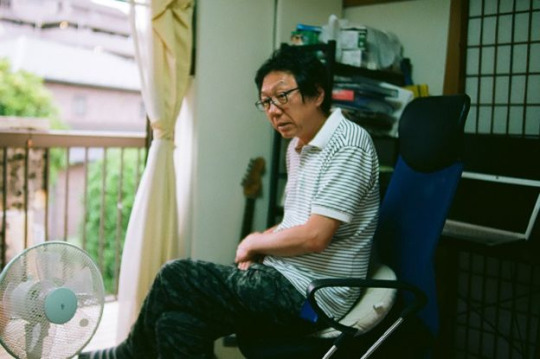
Mr Yoshikawa opened his first free school in 2010, in a three-storey apartment in Tokyo's residential neighbourhood of Fuchu.
"I expected students over 15 years old, but actually those who came were only seven or eight years old," he says. "Most were silent with selective mutism, and at school they didn't do anything."
Mr Yoshikawa believes that communication problems are at the root of most students' school refusal.
His own journey into education was unusual. He quit his job as a "salary man" in a Japanese company in his early 40s, when he decided he wasn't interested in climbing the career ladder. His father was a doctor, and like him, he wanted to serve his community, so he became a social worker and foster father.
The experience opened his eyes to the problems children face. He realised how many students suffered because they were poor, or victims of domestic abuse, and how much this affected their performance at school.
Part of the challenge pupils face is the big class sizes, says Prof Ryo Uchida, an education expert at Nagoya University.
"In classrooms with about 40 students who have to spend a year together, many things can happen," he says.
Prof Uchida says comradeship is the key ingredient to surviving life in Japan because the population density is so high - if you don't get along and co-ordinate with others, you won't survive. This not only applies to schools, but also to public transport and other public spaces, all of which are overcrowded.
But for many students this need to conform is a problem. They don't feel comfortable in overcrowded classrooms where they have to do everything together with their classmates in a small space.
"Feeling uncomfortable in such a situation is normal," says Prof Uchida.
What's more, in Japan, children stay in the same class from year to year, so if problems occur, going to school can become painful.
"In that sense, the support provided for example by free schools is very meaningful," Prof Uchida says. "In free schools, they care less about the group and they tend to value the thoughts and feelings of each single student."
But although free schools are providing an alternative, the problems within the education system itself remain an issue. For Prof Uchida, not developing students' diversity is a violation of their human rights - and many agree.
Criticism of "black school rules" and the Japanese school environment is increasing nationwide. In a recent column the Tokyo Shimbun newspaper described them as a violation of human rights and an obstacle to student diversity.
In August, the campaign group "Black kosoku o nakuso! Project" [Let's get rid of black school rules!] submitted an online petition to the education ministry signed by more than 60,000 people, asking for an investigation into unreasonable school rules. Osaka Prefecture ordered all of its high schools to review their rules, with about 40% of schools making changes.
Prof Uchida says the education ministry now appears to accept absenteeism not as an anomaly, but a trend. He sees this as a tacit admission that futoko children are not the problem but that they are reacting to an education system that is failing to provide a welcoming environment.
120 notes
·
View notes
Text
Heeding the Call: Cthulhu and Japan
Depending on your interests, the name Cthulhu may stir feelings of some strange familiarity, or an excited, nearly existential sense of horror to come. Despite the fiction that birthed much of the “Cthulhu Mythos” being moderately popular, the cosmic horrors introduced by H.P. Lovecraft have morphed into a life of their own thanks to the work of his protege, August Derleth, leaving future generations to encounter the unknowable in various forms spanning video games, tv shows, movies, and perhaps the most popular forms, table-top roleplaying and board game experiences. Perhaps less well known, though, is the fact that the Cthulhu Mythos is exceedingly popular in Japan, and has a wide and exciting history of adaptations, works, and impact upon many of the genres we love in Japan to this day. Today, we’ll be taking a look and exploring that history!
The history of Cthulhu in Japan is a bit more diverse than you might initially think, and isn’t as unified as it might seem! The first bits of spreading horror came from translations of H.P. Lovecraft’s original works into Japanese in the 1940s, appearing in the horror publication Hakaba (or Graveyard) Magazine, translated by Nishio Tadashi. These early translations would prove vastly popular, and over the years ended up leading to numerous Japanese adaptations and inspirations based on Lovecraft’s original works.
Anime and manga fans are likely somewhat familiar with Kaoru Kurimoto, creator of Guin Saga, Hideyuki Kikuchi, creator of Vampire Hunter D, fan favorite horror author Junji Ito, and legendary mangaka Shigeru Mizuki, who all claimed Lovecraft as a direct influence on their works at some point. That existential, cosmic, unknowable horror is certainly present in Ito’s works like Uzumaki, and Mizuki’s interest in folklore and yokai make an attraction to the Cthulu Mythos a lot more understandable. Mizuki actually drew an adaptation of the classic story The Dunwich Horror under the title Chitei no Ashioto, simply moving the story and characters to Mizuki’s beloved setting of rural Japan.
Perhaps one of the most influential Lovecraft inspired creators in anime though is Chiaki J. Konaka, likely best known to many for his work on series like Serial Experiments Lain, Digimon Tamers, and Big O, as well as other series like Armitage III (which takes its name from a Lovecraft character!), RaXephon and Texnolyze among many others. Konaka’s career extends into the Tokusatsu side of things as well, having worked on numerous Ultraman series ranging from Tiga, Gaia, Max, and more, as well as many other series. Konaka worked in references to the Cthulhu Mythos into many of his projects, and even wrote his own short fiction; one of them, Terror Rate, was even published in English, and was even a guest of honor at the HP Lovecraft Film Festival in 2018!
Much of the spread and popularity of Cthulhu fiction in Japan is owed to a few people, one of the most notable being Ken Asamatsu. Asamatsu has spent much of his career translating and spreading Lovecraft’s works in Japan, running fanzines and other publications in order to spread his love of the existential dread universe. While Asamatsu has worked on a few manga himself, he isn’t exactly an anime or manga creator, but without his input and dedication, it is unlikely that these works would ever be as popular as they are today!
Existential, creeping, unknowable horror translates well to other mediums as well, so it should come as little surprise that video games share various callbacks and influences from the Cthulhu Mythos as well. Atlus’s Shin Megami Tensei series and its many spin-offs feature numerous callbacks to Cthulhu Mythos characters and creatures, with some of the most obvious being Nyarlathotep’s direct role in Shin Megami Tensei: Persona and Persona 2. Many of the other titles reference things like the Necronomicon, with that same text being the initial persona of Persona 5’s Futaba Sakura.
Aside from Shin Megami Tensei, there are less obvious, but somewhat hard to miss, references to many of the tropes and unique style of horror in the Cthulhu Mythos in From Software’s Demon’s Souls, Dark Souls, and most directly Bloodborne games. Demon’s Souls in particular draws heavily on the existential, unknowable horror that is descending upon the kingdom of Boletaria and the secrets behind its true collapse, and the Dark Souls games similarly feature somewhat Lovecraftian ideas and monsters. Of the three, Bloodborne is the most direct with its inspirations, with characters routinely discussing the fact that seeing more of the truth may drive one mad, cosmic entities controlling, mutating, and destroying humanity, fish people (a staple of Lovecraft’s works), and humongous, tentacle-faced monsters (here known as Amygdala).
Ironically, however, there is actually another reason for the popularity of Cthulhu Mythos in Japanese media that helped spread its flavorful influence amongst various genres, and it actually has little to do with Lovecraft’s actual writings themselves. Instead, many Japanese fans encounter Lovecraft’s elder gods through the table-top role-playing game Call of Cthulhu, first published in Japan 1986, and the explosion in popularity was not only a staggering success, but it continues to this day! Although many Western fans might assume that TTRPG games like Dungeons and Dragons are popular in Japan due to some of their influences in fantasy anime, Call of Cthulhu reigns supreme as the most popular TTRPG in Japan, and its popularity likely helped introduce many Japanese to the TTRPG genre in the first place!
Call of Cthulhu is, essentially, a group mystery adventure game, and that seems to have really hit big with Japanese audiences far and wide, because the game has remained in print since its initial introduction in the nineties, and has fans of all ages and genders playing in groups, to the point that some places will find their rooms for group meetings rented out to play games of Call of Cthulhu! Recently, the game even got some favorable air time in an NHK news segment, talking about the game itself and the fun that can be had with it! With this popularity came the growth of a somewhat unique phenomenon: Replays, essentially narrative, semi-novelized versions of Call of Cthulhu campaigns collected and printed for other people to read, similar to today’s popular “actual play” podcasts and videos such as Critical Role or The Adventure Zone. Even today, Call of Cthulhu replays are extremely popular, with new versions being printed all the time, sometimes even adorned with amazing, cute anime styled art and other interesting little design choices, like semi-doujinshi level works featuring Touhou characters, and more! These Replays became so popular that they soon spread to other types of TTRPGs, and are the inspiration behind anime such as Record of Lodoss War, Slayers, and many others!
If one were to search Cthulhu on Amazon.jp, you’d actually find that most of the results are these colorful and interesting Replay books, almost more so than you’d even find the original novels and stories by Lovecraft himself! There are many other fascinating fan inspired books about the Cthulhu Mythos, including a personal favorite of Cthulhu monsters arranged in a book similar to those of Kaiju and Tokusatsu stylings (even featuring a cartoon Lovecraft on the cover doing the famous Ultraman pose). There are other small Cthulhu publications in Japanese, include a manga anthology called Zone of Cthulhu and numerous adaptations, and Gou Tanabe’s versions are even being translated into English, with The Hound and Other Stories already available, and At the Mountains of Madness coming later this year.
Of course the Cthulhu love isn’t limited to just print media; many anime have featured some nods and callbacks to the mythos, such as in the visual novel and anime of the same name Demonbane, which is even set in Lovecraft’s beloved Arkham. Main character Kuro Daijuji works with Al Azif, the living personification of the Necronomicon, to defeat the nefarious Black Lodge (a very probable nod to David Lynch’s Twin Peaks here). As mentioned above, numerous works by Chiaki J. Konaka draw from the Cthulhu Mythos, but Digimon Tamers might be the most surprising, with callbacks to Miskatonic University and Shaggai, as well as a computer AI that seems to have more in common with the Great Old Ones than it does Skynet! Another example is a fairly popular series, Bungo Stray Dogs, where one of the characters... is actually named Lovecraft! But that's not all! His "The Great Old Ones" ability is a reference to Cthulhu's origins. Probably one of the most famous examples is Nyaruko: Another Crawling Chaos, where the monsters of Lovecraft’s works are revealed to actually be aliens, but still very weird! The anime is a comedy featuring numerous Mythos characters repurposed or slightly renamed, such as Nyarlathotep as Nyaruko, the Yellow King Hastur, and more. The series of novels proved popular enough to spawn 3 anime seasons and other spin offs, proving that even if you take the horror out of the Mythos, people will still find it entertaining and… cute?
Speaking of cute, this brings us to a few interesting final tidbits about the Cthulhu Mythos and Japan. Aside from the direct popularity, the language change and differences have led to a few running gags in Japan about the series, one of which has to do with the somewhat infamous Cthulhu cultist chant, “Ia Ia Cthulhu Ftaghn,” with “Ia Ia” being pronounced very similar to the Japanese expression “iya iya”, which has a few various uses in casual Japanese, either meaning something similar to “um” or “no” depending on how and where it is used. The second comes from the fact that Japanese, being a syllabic language, actually has an easier time pronouncing the supposedly “unpronouncable” names of the Cthulu Mythos creatures, with Cthulhu being translated as クトゥルフ, or “Kutourufu”, which is not only a lot easier to actually say, but sounds oddly cute for the sinister elder god!
Cthulhu mania seems as popular as ever both outside and inside of Japan, with new games, movies, comics, and more drawing inspiration from the titles. Although Lovecraft’s own works are less popular than when the fascination started, the current passion for his ideas stems from the attractive allure of the unknown, the potential darkness lingering in shadows and dark pools of water. Whatever the reason people flock to the Cthulhu Mythos, it seems like we can look forward to numerous adaptations, inspirations, and callbacks for years to come… until perhaps even Cthulhu awakens! Until then, it’s best to keep your wits about you and stock up on your esoteric lore… You never know where the elder gods might pop up next during your next anime, manga, or video game binge!
Have any secret and mysterious ancient Cthulhu influences we didn’t mention? Know of any other influences on Japan you’d like us to cover? Let us know in the comments!
----
Nicole is a features and a social video script writer for Crunchyroll. Known for punching dudes in Yakuza games on her Twitch channel while professing her love for Majima. She also has a blog, Figuratively Speaking. Follow her on Twitter: @ellyberries
Do you love writing? Do you love anime? If you have an idea for a features story, pitch it to Crunchyroll Features!
3 notes
·
View notes
Photo






greatrunner’s favorite series and films of 2018 (in no particular rank/order):
erased (miniseries) (dir. ten shimoyama, etc.) >> into the forest (dir. patricia ruzema) >> the many faces of ito (miniseries) (dir. ryuichi hiroki, etc.) >> before we go (dir. chris evans) >> hello my twenties (season 2) (dir. lee tae gon) >> laggies (dir. lynn shelton)
[Trigger Warning: References to sexual assault and abuse in #2 and #5]
1. Erased – Ten Shimoyama – 2017 – Japanese Dramas available on Netflix are more miss than hit, and are largely overwhelmed by South Korean Dramas. Finding anything good on Netflix’s streaming service is a task in and of itself, but you find it, you’ll quickly drag the experience out for as long as humanly possible. Erased is a Netflix-produced miniseries – originally a manga –that focuses on the time travel exploits of a young man (with a bad case of self-loathing and [suicidal] depression), whose mother is murdered. Seemingly trapped in the past as his kid self, he tries to figure out what caused his time travel and how to prevent the death of not only his mother, but a young girl who went missing when he was a child. Erased is a melodrama through-and-through, but knows how to balance its drama. It never once feels any of the characters are being undermined, and subplots are handled fairly well. The performances from the cast are stellar, especially with regard to the child actors. These kids really make it worth sticking with the show until the end.
2. Into the Forest – Patricia Ruzema – 2015 – Into the Forest is a “post-apocalyptic” film that chooses to focus on the gradual reshaping of one’s life instead of glamorizing the violence and gore that has become a bog-standard of the genre. In a somewhat removed future, two sisters (portrayed by Ellen Page and Evan Rachel Wood) attempt to eke out a living in a swanky minimalist house with exposed glass windows, far removed from most of city life, in the middle of a forest. When their father dies in in accident (his leg is sliced by a homemade blade for a chainsaw), they find themselves at odds on how to keep going. The film is extremely minimalist, choosing to focus on how the sisters break and bend under their own grief and increasing obstacles. If I have one disappointment with the film, it’s that it chooses to include a rape sequence in the film (about half-way through the film), and it soured my experience of the last hour or so of the film. I think it handles the subject well enough, and get the argument the director made for its inclusion, but I was just hoping it’d be the one end-of-the-world film that wouldn’t do that shit.
3. The Many Faces of Ito – Ryuichi Hiroki – 2017 – The Many Faces of Ito deals with the subjects of emotional manipulation, cheating, and good ole ageism. When a woman is tasked to find a narrative that will top longstanding drama that put her on the map of mainstream success, she is faced with several women who’ve all dated a man named “Ito”. She doesn’t have the highest opinion of these women – believing most of them have put themselves in positions with this Ito character that show them for the weak-minded and weak-willed people she thinks they are. However, a lot of her commentary is self-reflective – she hasn’t exactly gotten over the heartbreak of a relationship with her boss (who she is still working with) – and is big into self-hatred – by doing it to other people. The Many Faces of Ito was produced by Netflix and has the weird fortune of being both a movie and a miniseries. I watched the miniseries first, and it’s decidedly more sympathetic toward the women than it is toward Ito. The film iteration, on the other hand, seems to have all the sympathy in the world of the shit-heel named Ito, but almost little for the women, to the point where Ito is allowed to monologue self-important speeches about why he treats women the way he does. And the worst part about it is that film supports his theory wholeheartedly. If you’re going to watch any version of Ito, I’d stick to the miniseries and just leave the film alone (it’s basically a much more condensed version of the series). The show has some solid performances and if you can deal with melodrama at its highest, you’ll probably find something to enjoy in this.
4. Before We Go – Chris Evans – 2015 – Chris Evans’ track record with romantic films – romantic comedies, really – is terrible. Knowing that he ended up directing and starring in this, shortly after starring the repulsive film Playing it Cool, had me prepared for the worst. But, Before We Go isn’t bad little film, least-of-all for a guy’s first directorial effort. It has a lot in common with the Miramax film Last Night (starring Keira Knightley and Sam Worthington). An estranged wife (Alice Eve) is dealing with the fact that her husband has cheated on her and spirited away to New York after writing a scathing “divorce” letter to him. She immediately regrets it – afraid of being a lonely spinster –, tries to get on the last train back to Boston and fails. She ends up meeting a struggling musician named Nick (Chris Evans), who decides to help her get back to Boston, if only to avoid a Jazz audition and closing the book on a relationship that he desperately wants to rekindle, but knows won’t work out because “the love of his life” has (smartly) moved on. It’s a quiet little movie, full of the usual romantic discourse that romanticizes or justifies relationship angst (“We love who we love. Sucks.” / “You don’t allow yourself to find perfection in others if you’re committed to someone else.”), but the performances from Alice Eve, Chris Evans and the supporting cast around them supports the film tremendously. I love the movie, but I’m a sucker for perfect strangers meeting, becoming friends and departing from one another with no certainty that they’ll ever meet again. That’s life, that’s a lot of encounters in my life, so I kinda appreciate how it ends and how it got there. It’s nowhere near the level of Last Night (“What I wouldn’t give to have tired of you”), but it’s good. I liked it.
5. Hello my Twenties (Season 2) – Lee Tae Gon – 2017 – The second season of Hello My Twenties (or Age of Youth) sees a major cast upheaval and departure, but otherwise manages to maintain what made the first season enjoyable and not just watchable. New characters add different story elements that keep the momentum going, and the continuation of previous narrative threads that were left hanging in the first. The season deals with subconscious and persisting trauma related to kidnapping, stalking, and child molestation, and for the most part, handles all of those subjects quite well without ever turning to blame the victim of their stories. If you’re on the lookout for a K-drama that deals with female friendships and isn’t heavy on melodramatic romance, Hello My Twenties is the series for you.
6. Laggies – Lynn Shelton – 2014 – Laggies follows the story of a 28-year-old woman with no real direction or goals in her life. She struggles to keep a job down and is working for her father’s business – something her friends look down on her for – and is stuck in a relationship she is neither interested in or really prepared for once her boyfriend proposes to her. Keira Knightley’s character isn’t dissimilar to Hugh Grant’s from About a Boy, she’s just a broke American Woman-child instead of a rich British Man-child. When she starts hanging out with teenagers, who think she’s the coolest person in the world because buys them booze and doesn’t tell them what to do, the film is quick to make jokes about why a 28 year old woman is hanging out with a bunch of errant teenagers. Instead of laughing, you as an audience member are just reminded that she’s one of those adults other adults warn yo to stay away from when you’re a kid. When she falls in love with one the teen’s fathers, she struggles to get some real direction in her life and whether or not she should cut all ties with a group friends and a boyfriend who are all too content to dog-pile on her.
#best of 2018#movieedit#netflixedit#erased netflix#before we go#hello my twenties#laggies#the many faces of ito#into the forest#[greatrunners graphics]
4 notes
·
View notes
Text
Hanyu Yuzuru - Starting from his face, Falling for his talent, Staying for his character
Note: This is a translation of an original article by Vogue China for their WeiXin/WeChat mobile platform. I’m quite surprised this actually made the cut, even if it’s just content for Vogue China’s mobile platform. What started as a Hanyu costume appreciation article quickly revealed its true form as a Hanyu appreciation post and the fangirling is anything but subtle. Not that I minded Ci The words in the brackets and the ~ are not my translator’s notes and personal input but are part of the original article. Captions for photos are in italics.
Click the link to view the original article: https://mp.weixin.qq.com/s/9bHolfsTxbJ2XYsmG465ng
There are more pics and gifs there, the writer has definitely spent a lot of time and effort on this labor of love so do check it out. Even if you don’t understand Chinese, a picture speaks a thousand words, so let all the pics do all the talking for you.
Hanyu Yuzuru - Starting from his face, Falling for his talent, Staying for his character 始于颜值,陷于才华,忠于人品 (T/N: Describing the journey of most fans - you notice his good looks first, then you appreciate his talent and you stay as a fan/become a loyal fan due to his outstanding character)
"Blue roses do not exist, Hanyu as well, he gives an impression that he does not belong in this world", Japanese photographer Ninagawa Mika has said this of Hanyu Yuzuru. This youth who is already a legend at the tender age of 23, what other miracle-like surprises can he bring us?
Every year, the Japanese imperial family will host a spring garden party and invite outstanding personalities from all fields to view the flowers, converse, eat delicious food and listen to music at the Shinjuku Gyo-en.
This year, among the 1940 guests, one person’s arrival created a stir among the assembled ladies - he is 2 times Olympic champion Hanyu Yuzuru.
Just a few days ago. Hanyu Yuzuru held a celebratory parade in his hometown Sendai with over a hundred thousand people in attendance. This year, he was invited to the garden party (the last time was after he won in 2014), and even the princesses revealed that they had held hands together to cheer for him (insert fangirl heart eyes) ~
In this type of formal setting, female guests normally choose kimonos or suits while male guests usually appear in hakamas, suits or uniforms.
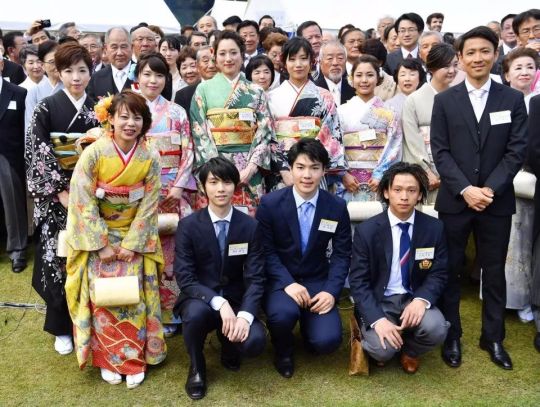
Hanyu who has donned suits both times has said that he prefers a slim-cut which fits his body well. He might have said so, but perhaps Hanyu is too slender (actually his muscles are well-developed, and his body fat percentage is super low), it is hard for a run-of-the-mill suit to fit well on his body.

Hanyu at last week’s parade. His suit might not be the best fit, but it is way better than his uncle suit from years ago~
Compared to the western suit, actually a traditional hakama suits Hanyu better, but this super low-profile Olympic champion really doesn’t have too many opportunities to show us~
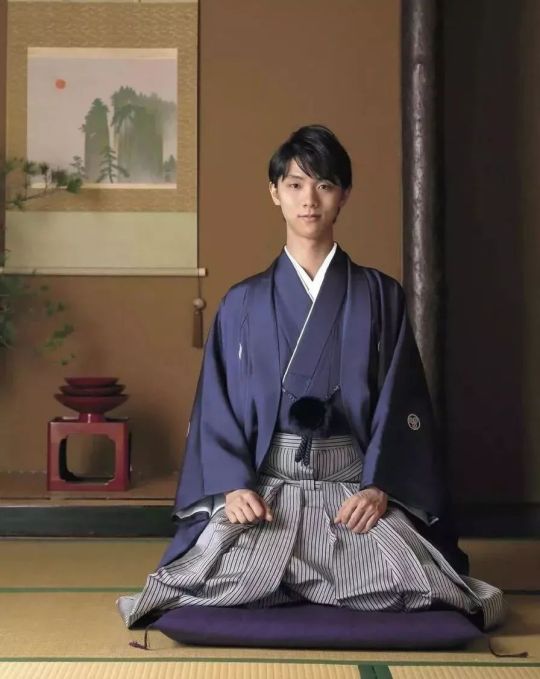
Hanyu’s first appearance in a hakama for a 2015 photo shoot
A earphone-maniac and game otaku, this prince-on-ice who exudes an ethereal aura doesn’t really care about fashion in his private style, basically he lives in sportswear.

Sportswear can actually look so good ~~
He seldom does magazine photo shoots, after all he is not an idol or celebrity (but once he does, it’s a big production)

Hanyu captured by Ninagawa Mika for Aera magazine
However on the ice, Hanyu’s style is varying and elaborate, every costume can be said to be a piece of art. Asymmetrical designs, crystals, gradation, Japanese style, classic, lace…...a perfect combination of masculine heroic spirit and feminine softness and beauty.
Figure skating is about both athleticism and artistry, and as the ‘absolute champion’ of this sport, Hanyu has already declared that he is one-of-a-kind just from his costumes.
CHOPIN BALLADE NO.1
— YUZURU'S COSTUME —
The most beautiful moment
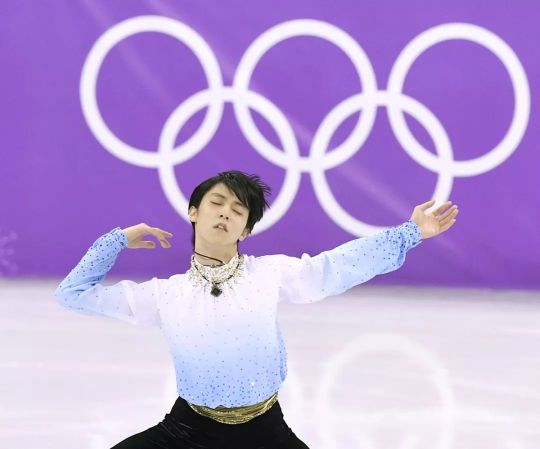
The Olympic version where he passes his hand through his hair with shut eyes
We’ve already established that Hanyu is a ‘skating fairy’, Chopin is a program which best embodies his ethereal aura and elegance.

After the end of the 2014 Olympic season, Chopin V1.0 made its debut. From the white to blue gradation, the rows of crystal embellishments and the flowy lantern sleeves, it creates the effect of a grand introduction and conclusion while on the ice, and reflects the leisure and calmness of this well-known piece of music.
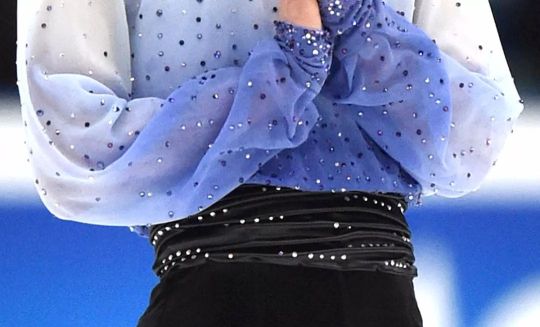
Close up of V1.0. Not only are there rhinestones, you can also see the blue-purple pearl embellishments
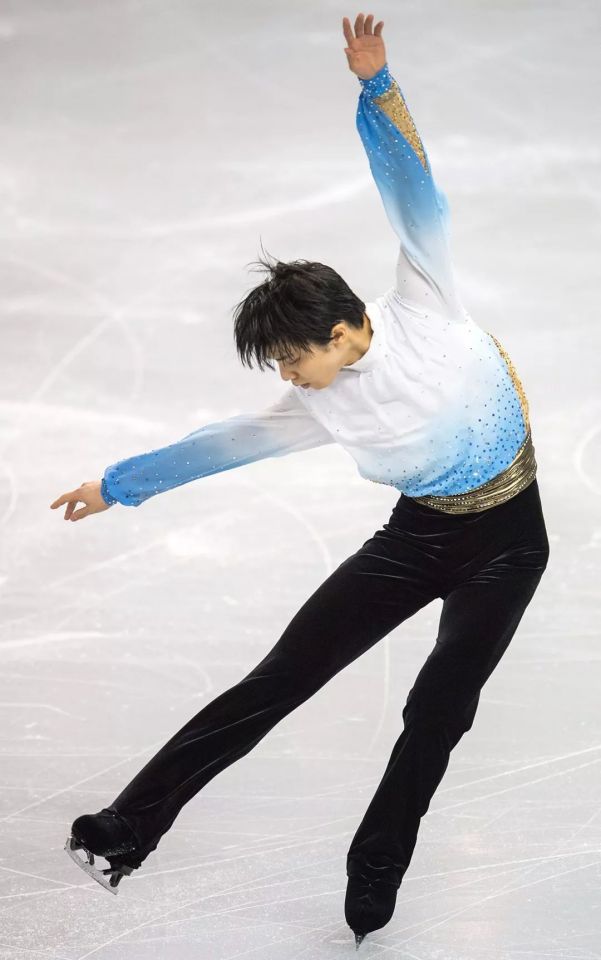
Chopin V2.0
For Chopin V2.0 in the 2015 season, the color of the costume has changed from sapphire-blue to sky-blue, and gold elements have been added to the sleeves and waist. The belt is changed to gold as well (all of these reflecting the champion’s desire for gold).

Olympic Chopin V3.0
For the Olympics season, the chosen blue shade is a deep sky-blue in between the colors of the previous versions. The gold elements are up-up-upgraded as well - gold crystals and pearls are added to the neckline and the colorful rhinestones on the gold belt are extremely shiny (yet very lowkey), a perfect complement to the rush of thick emotions and fanatical fervour of the ballade’s climax.
SEIMEI
— YUZURU'S COSTUME —
The most beautiful moment
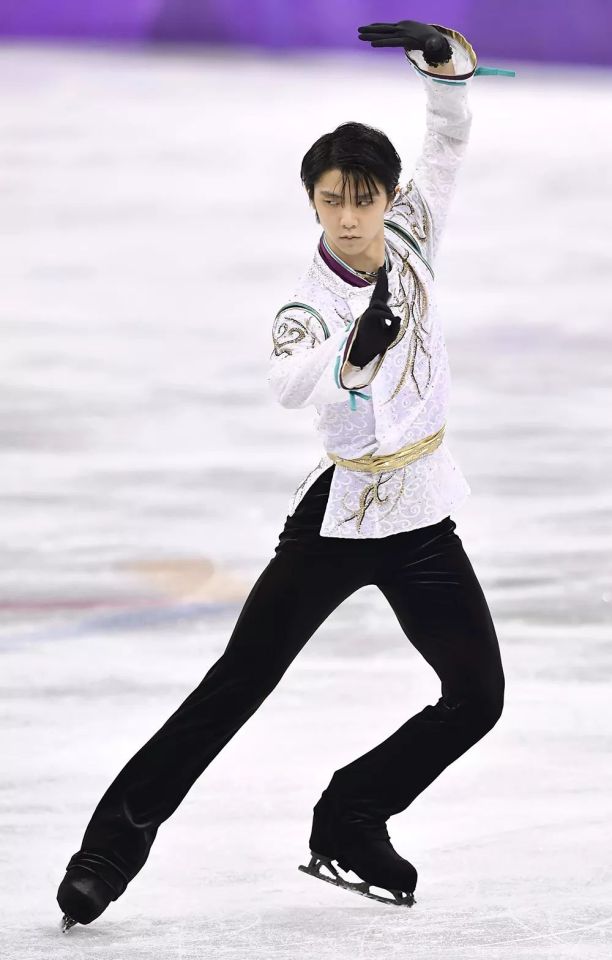
The opening “ Guiding both heaven and earth onto the right path” action
Hanyu’s signature hydroblading move (Hanyu himself says his eyes here can kill~)
Among all of Hanyu’s programs, Seimei which was inspired by the movie Onmyouji is definitely the most famous.
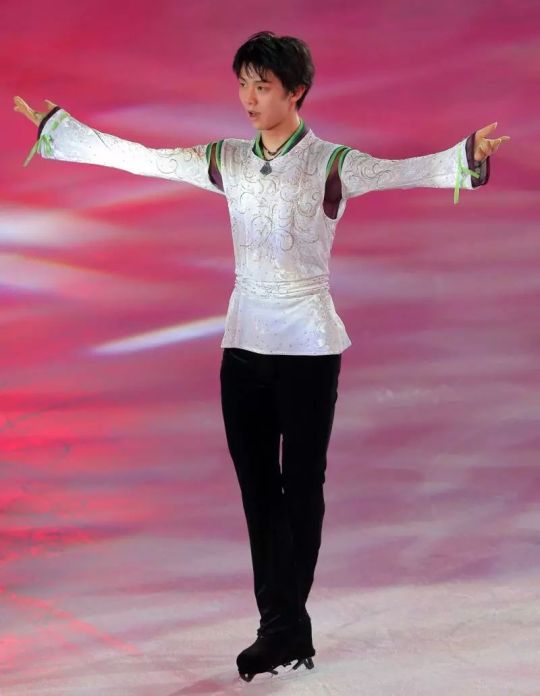
Seimei V1.0
At an ice show before the start of the 2015 season, Hanyu revealed this program for the first time. After being redesigned by designer Ito Satomi and Hanyu, the Heian-era karigime becomes a lighter, more convenient and fitting costume.
Still from the movie Onmyouji, played by Nomura Mansai
Kyogen stage actor Nomura Mansai who plays Seimei in the movie had a one-to-one exchange with Hanyu and gave him a lot of suggestions on the hand movements, rhythm control and character understanding. When the program was officially debuted in competition, we saw ‘Hanyu Seimei’ V2.0.
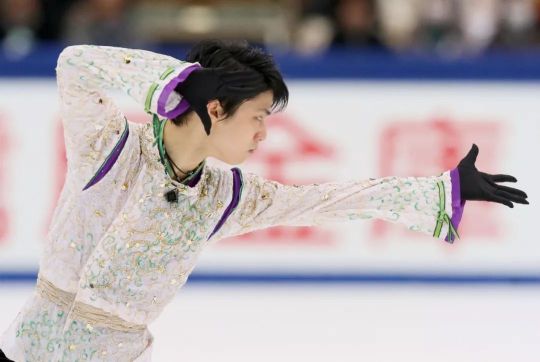
The most obvious changes were that the shoulders and waist were looser so as to allow for easier movement. The light green ribbon ties on the sleeves are now bordered by grass-green. There is an additional mesh insert on both the front and back. More gold embellishments and green embroidery and rhinestones were added. And the black gloves - there are many hand movements when Seimei casts his spells and the contrast between the black gloves and white rink is more stark.
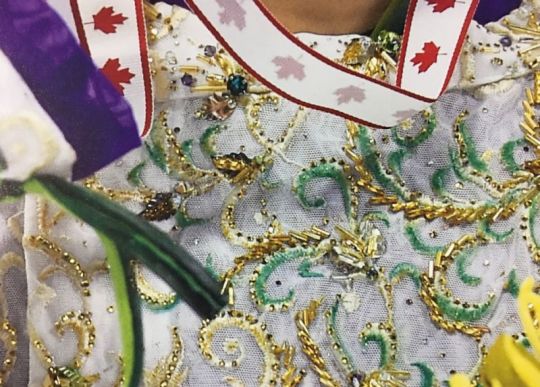
Close up of V2.0 details. Intricate gold bead work, embroidery and rhinestones
During this Olympic season, V3.0 makes an appearance. A large portion of the bead work and embroidery is removed and replaced with crystal embellishment instead (3000 pieces were allegedly used). The main reason for this change is to lighten the weight of the costume so that it is easier to jump.
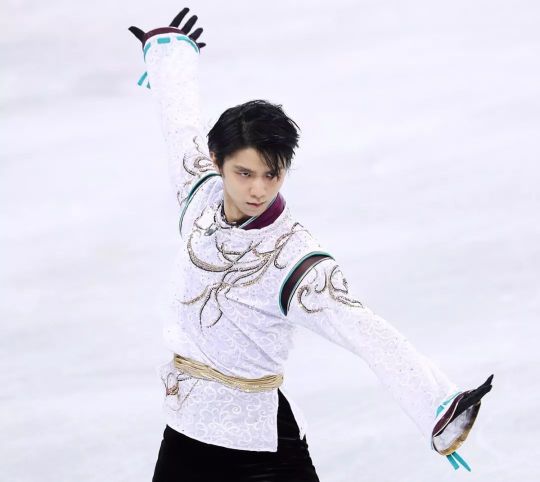
Even the belt is changed to a gold color which looks more majestic and as per the old design, it is embellished with crystals of varying sizes. There is a slight change in the color of the costume as well; a touch of deep red is added to the purple while the lace ties becomes cyan/teal.

The front, back, sleeves and even the lower part of the shirt is embroidered with an even more lavish golden phoenix design (all in all, the champion must be commanding + regal), at the back there’s even a signature Seimei ‘5 point star’.
Usually, skating to Japanese-style music is not favorable in international competitions, but this program has helped him broke the world record twice and win the Olympics again in 2018. Actually, just from the details on this costume, you can already see how much he has fine-tuned this program’s choreography.
LET'S GO CRAZY
— YUZURU'S COSTUME —
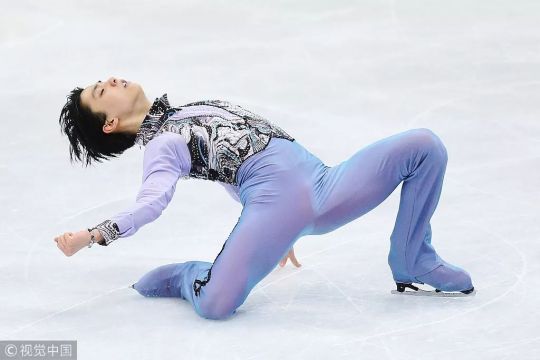
Skating on bent knee while bending backwards
In all of Hanyu’s programs, Let’s Go Crazy (nicknamed ‘Go Crazy’ by fans) is the program which drives fans the most-most-most crazy. Basically every time you watch it, you get a nosebleed. All the lil actions woven in the program are designed to bedazzle and drive you crazy.
This is Prince’s famous song. In April 2016, the pop star passed away. Hanyu, who was then preparing for the new season, together with his choreographer decided to use this song as a tribute to Prince and came up with a crazy and bold program.

Comparison of the LGC costume with Prince’s costume, Yuzu’s costume is actually slightly sheer

The inspiration for the costume came from Prince’s concert. This song was in the album ‘Purple Rain’ so the costume was mainly in purple. The vest over the shirt and the standing collar were all references to the outfit worn in the MV. The bead work and sparkles on the vest were also designed based on the photos.
His hair was also styled differently from the usual, his hair was combed back in a style that reveals his forehead, which was rare. Actually his hairstyle was based on Japan’s ‘i-ta men’ style. This term originates from the samurai Date Masamune who lived during the Japanese warring period. He was brave and valiant and excellent in warfare, yet he dressed magnificently, so ‘i-ta men’ was used to describe such men. Later it evolved to describe playboy/dandy type of men.
NOTTE STELLATA
— YUZURU'S COSTUME —
The most beautiful moment
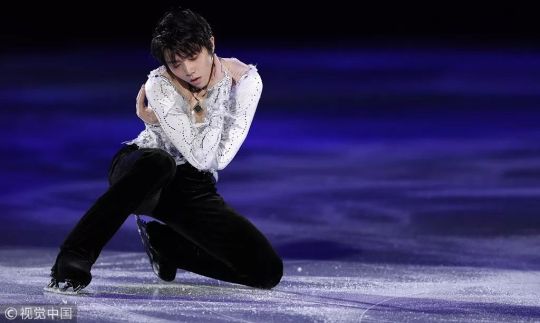
His silhouette during the sit spin resembles a swan
Notte Stellata is an exhibition program which Hanyu used for 2 seasons. In Italian, Notte Stellata means ‘a sky full of stars’.
During the Great East Japan earthquake seven years ago, Hanyu was at the Sendai ice rink practicing and after escaping, he sought refuge at a school gymnasium for several days. There was no electricity in the entire city and only the stars in the sky shone brightly, planting seeds of hope in the youngster’s heart and hence this program came to be.

Adorned with white feathers and featuring a daring off-shoulder design and deep V-cuts in both the front and the back, the costume has the grace and elegance of a swan; and the crystals scattered on the sleeves and the bodice are just like the stars in the sky.
Perhaps it is his perpetual youthful looks and his slender body frame, even in a design which seems feminine, Hanyu is able to make it his own. This is one of his special traits.
Actually most of Hanyu’s exhibition pieces revolve around a common theme - praying and wishing the best for the disaster area. Having ‘escaped’ after the earthquake, he has always felt that he has not done enough for the disaster area, so he has donated his bonus for winning the Olympics and the revenue from the sales of his autobiography and so on, and he has always tried his best to express these emotions during his exhibition skates.
Hanyu exhibition piece in 2015 Believe

Hanyu exhibition piece in 2012 Hana ni Nare
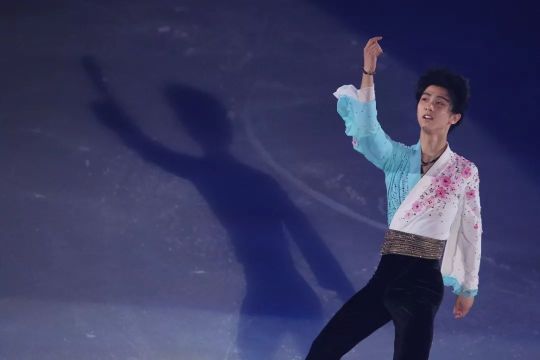
Hanyu exhibition piece in 2012 The Final Time Traveller

Hanyu exhibition piece in 2014 Hana wo Saku
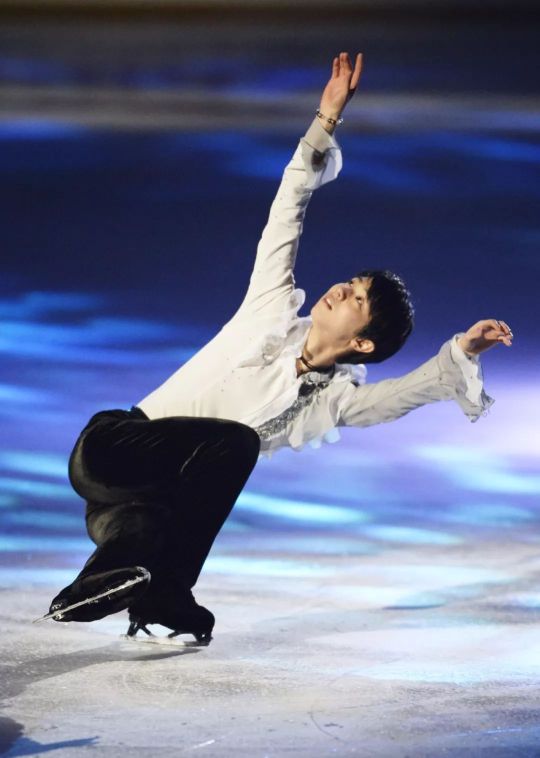
So most of Hanyu’s costumes for his exhibitions are usually softer compared to his costumes for his competitions and are usually made of chiffon with pleating and floral decorative details. Under the dim lights on the ice rink during the exhibition, it is like a beacon of light, full of life.
HOPE & LEGACY
— YUZURU'S COSTUME —
The most beautiful moment

Hanyu’s signature Ina Bauer
The Biellmann spin which usually can only be done by female skaters, it requires the body to be very flexible
This is the most emotive of all of Hanyu’s free skate programs and till today, it still holds the world record for the highest score for the free skate. Hope & Legacy is the theme song for the 1998 Nagano Paralympics and is composed by the famous Hisaishi Joe. And this year is exactly the year Hanyu started skating.
This program is like an exchange between Hanyu himself and the ice rink, Since he started skating at 4 years old, figure skating is almost his entire life. From longing to desire to adversity to fear and finally to the release of emotions and rapture, these were all showcased in a single breath.
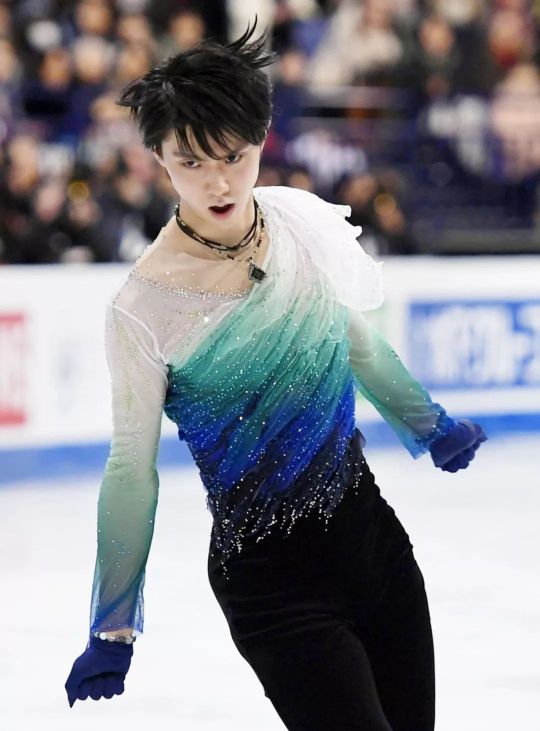
Just like the blue, green and white gradation signifies the the sky, the earth and the rink, everything is as natural as the floating clouds and flowing waters, and the scattered rhinestones are clustered even more closely than before, just like the shining marks that Hanyu has left behind in his journey.
It is indeed profound that after a mistake resulting in him in fifth place after the short program at the 2017 World championships, he went on to perform this free skate perfectly and broke the world record at 223.20 points, creating the impossible and aiding him in capturing the gold medal.
This costume actually has a ‘previous form’ six years ago. It was the season right after the 311 earthquake and the short program is titled Etude.

To Hanyu, this is a costume which was in remembrance of the disaster, the many layers of blue are used to express the giant waves and the sea and to commemorate everything that was lost in the earthquake and the tsunami. At that time, he was only 17 and he could already deliver such a soulful performance.
THE PHANTOM OF THE OPERA
— YUZURU'S COSTUME —
The most beautiful moment
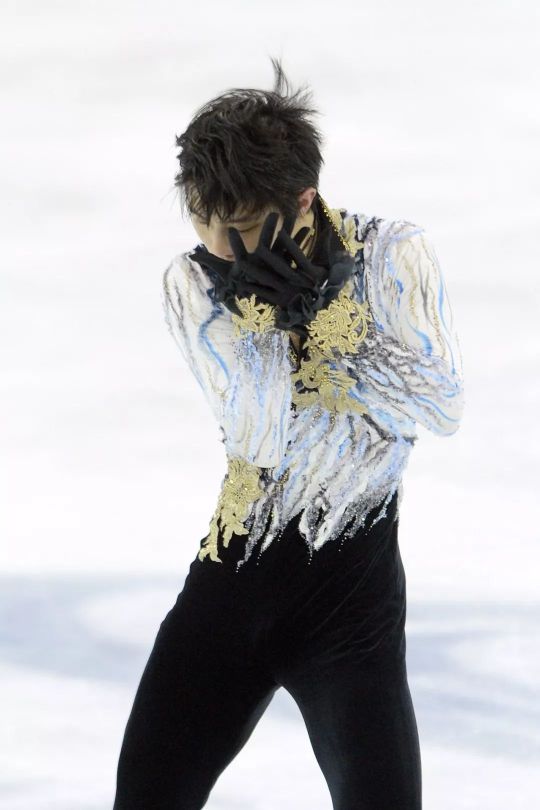
The hand movements depicting wearing and removing the mask
POTO is a classic song that has been used by many other figure skaters, yet Hanyu’s interpretation still manages to inject freshness.
The earliest version was pieced together from red, black and white fabrics in a asymmetrical fashion (the black part is openwork lace) and aptly fits the character who has lost himself in his obsession for his love and has the resplendence of the men’s court attire in the 19th century.
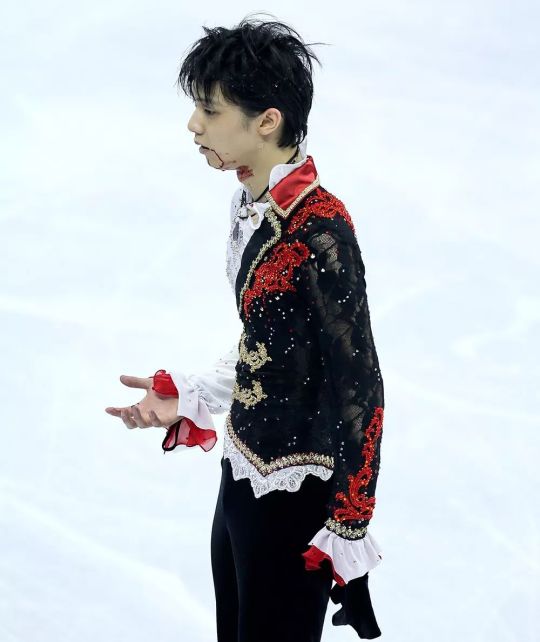
However, this costume was sealed after just wearing it once; before the competition he collided heavily with another skater and sustained severe external and internal injuries and even had to have an operation. Hence this version of POTO was never seen again in competitions.

The redesigned POTO costume went from figurative to an imagery style, the concept of the veined patterns are interlaced with the doomed love between the angel and the phantom, but the designs on the collar, the end of the sleeves and the waist still retains the elements of the Romanticism period.
PARISIENNE WALKWAYS
— YUZURU'S COSTUME —

The opening brushing his hands-over-head and raising his leg teasing move
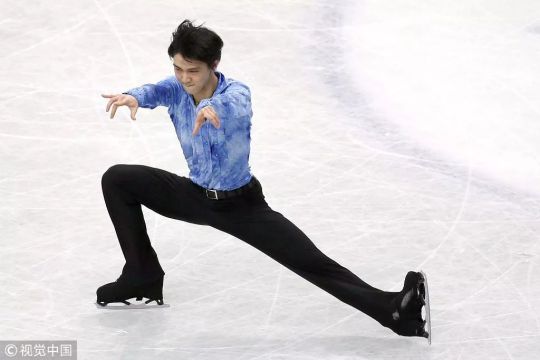
The handsome side-lunge and point move
Fans call it the ‘Big Parisienne Saunter’ and it’s the program that has made many fall for him. Hanyu started using this short program since the 2012 season, and it is from this time that he started breaking all kinds of records, and it even became the first short program to ever break the hundred point barrier at the 2014 Sochi Olympics.
At first glance, it looks like a simple shirt + belt + pants combination, but actually the shirt is full of thoughtful details: the pleats on the front and back are adorned with sparkles, and in line with the blue and white color scheme which seems like the blue sky, the sparkles look like shiny stars hiding in the clouds, which perfectly matches the aura of the youth who had just turned legal.
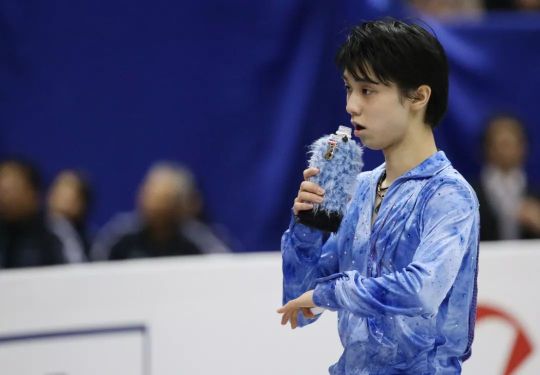
There’s a detail here, which is our ‘perfectionist’ Hanyu even had a matching bottle cover with his costume (it should be hand-made by Hanyu’s mum’s deft hands) ~
An elaborate figure skating costume can easily cost up to ten-thousands, Hanyu's costumes were initially designed and hand-made by his mother and subsequently he collaborated with designers Orihara Shizuko, Ito Satomi and famous figure skating veteran Johnny Weir. Every costume is worth to be admired and appreciated. Actually Japan is holding a Hanyu photo and costume exhibition, if you’re in town, why not go take a look?

2011’s Romeo & Juliet designed by Orihara Shizuko
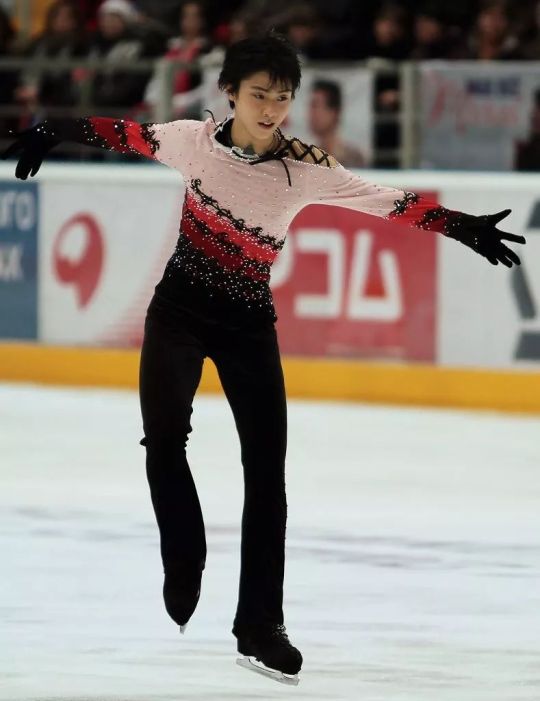
The costume for 2010’s Zigeunerweisen designed by Johnny Weir and handmade by Hanyu’s mum
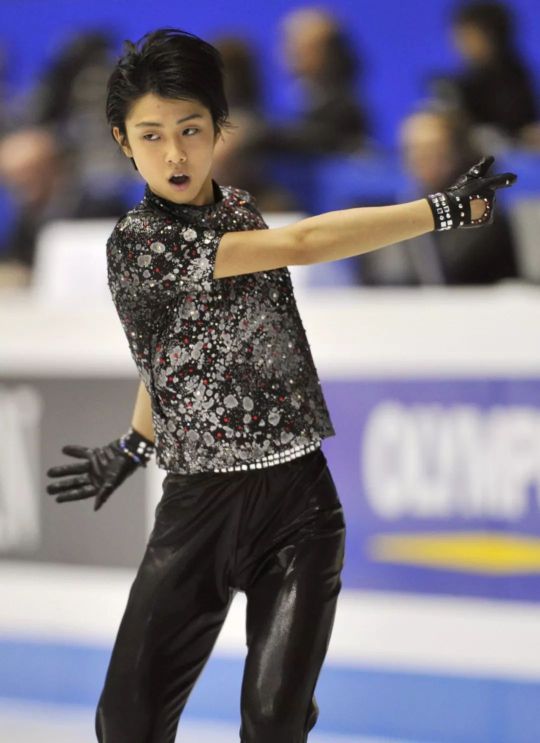
2009 Junior GPF’s costume for Mission Impossible
For an Olympic gold medallist to have such high popularity, can it just be attributed to his appearance and the sport’s intrinsic entertainment value? To explain, we can probably use the well-known phrase “starting from his face, falling for his talent, staying for his character”.
2 times consecutive Olympics champion, 12 times world record breaker and the current record holder for the highest scores for the short program, the free skate and the combined scores, behind these hard facts are his perfectionism and determined performances.
“There is no meaning if you do not try your best at doing what can be done, this cannot be called ‘staking your life’.”
Every time before he goes on the ice, he’ll touch the ice as a sign of respect towards the sport
To clearly say “hate to lose” these three words, Hanyu seems like a high-spirited teenager. As long as it’s a silver, he will be super frustrated. He doesn’t just does highly difficult jumps, he combines them with difficult entries and exits to score the maximum GOE. His techniques in competition are clean, there are definitely no petty tricks. He has many injuries and his condition seems to fluctuate high and low but he has never faltered at the crucial timing. When some athletes choose to retire after becoming famous, he is still passionate about the sport and has declared that he wants to challenge the 4A and quintuple jumps…… Just as Hanyu himself said, “I have bet my entire life on skating”.
Just a strong determination is not enough, Hanyu’s brain can be said to not lose to his athletic ability. He is enrolled in Waseda University and is able to respond within seconds to change his jump layout to make up for lost points. He has produced his own ice show and his candid responses to tricky questions from reporters are all charming points both on and off the ice.
“I do not talk about who my rival is, I am my only rival”
“Although this is just my way of thinking, the ‘plus’ and ‘minus’ in life will balance out, and finally result in zero”
We hope that the name ‘Hanyu Yuzuru’ will live on forever and become a power of vision and a light of tenderness.
261 notes
·
View notes
Text
To build an unimaginable future (or, Queenie is way too jazzed about queer futurity)
This post has been cross-posted to The Asexual Agenda.
This post was written for the April 2018 Carnival of Aces on “All the birds but us...” In typical Queenie fashion, I’m getting this in at the last possible second, but if you can type at supersonic speeds, consider writing a submission as well!
Content warnings: spoilers for a movie that came out in 1939, some pessimistic talk about the future and trauma
In spring of 2014, I was assigned a portion of Lee Edelman’s No Future for a class.
I hated it.
I hated it so much, in fact, that I vagueblogged about how much I hated it. I hated it so much that I decided that I was going to prove Lee Edelman wrong with every part of my existence. Like many things that I start as semi-jokes, it very quickly became not so much a joke as a way for me to conceptualize why what I was doing mattered.
Yeah, this is it. This is the post where I finally talk about queer* futurity.
A disclaimer to start: I’m not a queer theorist and I’m not super well-versed in queer theory in general. I find a lot of theoretical work convoluted and inaccessible (both to the general public and to me specifically), and my training is primarily as a historian and ethnographer. What I’m talking about here is not queer futurity from a theoretical perspective (although there’s been a fair amount written on it from that perspective, including work actively refuting Edelman)** but rather queer futurity from a personal perspective. This month’s Carnival of Aces prompt asks, “How did your (a)sexual and (a)romantic orientations impact your (expected or imagined) future?” and this is my answer.
That said, it’s probably important to explain what Edelman’s work is all about so that you know what I was reacting to. Here’s the blurb from Amazon:
In this searing polemic, Lee Edelman outlines a radically uncompromising new ethics of queer theory. His main target is the all-pervasive figure of the child, which he reads as the linchpin of our universal politics of “reproductive futurism.” Edelman argues that the child, understood as innocence in need of protection, represents the possibility of the future against which the queer is positioned as the embodiment of a relentlessly narcissistic, antisocial, and future-negating drive. He boldly insists that the efficacy of queerness lies in its very willingness to embrace this refusal of the social and political order. In No Future, Edelman urges queers to abandon the stance of accommodation and accede to their status as figures for the force of a negativity that he links with irony, jouissance, and, ultimately, the death drive itself.
Basically, Edelman links futurity with biological reproduction and then says that queerness’s power is negating or denying that future. (He says, at one point, that queerness is defined by having non-reproductive sex.)
There are a lot of reasons to hate this. First, there’s the weirdly exclusive definition of queerness. What about bi folks? What about trans folks? What about ace folks? What about gay folks who have biological children? Etc. etc. etc. Second, there’s the idea that the only way to have a future is to biologically reproduce. I know that Edelman has been (rightly) critiqued, especially by queer scholars of color, for discounting social reproduction--passing on culture and community to folks who are not blood relations, for example. If you want an example from my own studies, there are several medieval Buddhist sects in Japan that have master-disciple transmissions, where the master and disciple are not theoretically*** blood relations but still are part of the same lineage. Third, there’s this general sort of nihilistic, pessimistic way of thinking about queerness. I’m going to talk about that more below so I won’t go into it here.
Anyway, enough about this book that I didn’t like.
When I talk about queer futurity, I’m talking about a way of imagining a future connected to our present that doesn’t rely on biological reproduction. This probably sounds very conceptual and academic, so let me explain with some reasons why I am so excessively jazzed**** about queer futurity:
The first point is a bit of a weird and heavy one, so I apologize for starting with this but here goes: I don’t believe that “it gets better.” I understand that that’s often a comforting thought for LGBTQ folks (it’s the basis of the It Gets Better Project, after all), but it’s not for me. I don’t think that there will be a brighter, better future for me, because experience has yet to offer me any concrete proof that things will get better for me. I’ve known I’m queer for more than a decade, and things haven’t gotten better; they’ve just gotten hard in different ways.
On a related note, as I’ve mentioned before a couple of times, I have no real felt sense of the future and no ability to conceptualize what my future might look like. Part of that is PTSD (trauma does weird things to your sense of time) and part of that is a lack of role models. This is why things like “The Path of the New Woman” appeal to me--as Ito puts it, The New Woman “does not know where this new path originates nor where it leads. Consequently, she understands the danger and the fear that attend the unknown.” The future, to me, is scary but also fundamentally nebulous and unimaginable.
People often mistake me for an optimist, but I wouldn’t say I am. I don’t think the future is inherently a better, brighter place. I don’t think the sun will come out tomorrow.
What I do think is that if tomorrow continues to be dark, the least I can do is make sure that whoever comes after me has a flashlight.
And this is where queer futurity comes in for me--being able to conceptualize a better future not for myself but for the people who come after me, but also being able to conceptualize a way that I am connected to and contributing to that future. Because the idea that I’m disconnected from the future entirely or that I’m negating it in some way? That’s hopelessness. Because if nothing will get better for me, if my future is already so inherently difficult to imagine, and if I will not have any legacy to pass on to the next generation, there’s no point in me continuing to survive. (As I’ve said before, my ability to care for myself goes up substantially when I have other people to take care of.)
So, for me, queer futurity is hope, not that things will get better, but that I can make them better for whoever comes next, that whatever I build (whether that’s resources or community or just plain ol’ relationships with other individuals) will live on beyond me.
Needless to say, a big part of queer futurity for me is conceptualizing alternative families (found family is lovely!) but also ways to have an impact on the next generation that don’t require a family. When I was in my preteens, I saw Goodbye, Mr. Chips and I sobbed through the ending. If you haven’t seen the movie, it follows a teacher at a boys’ school from his first day teaching until his death. On his death bed, one of his colleagues remarks that it’s a shame he never had children, and he responds, "I thought you said it was a pity, a pity I never had any children. But you're wrong. I have! Thousands of 'em, thousands of 'em...and all...boys." (You can find a clip of the scene in question on YouTube.) This appeals to me because I’m a sap who cries about gum commercials***** but also because it’s very much in line with how I imagine my own role as a teacher, an educator, and a mentor.
I am not planning on having children--either biological or adopted. I have no intention or desire to pass on my family name--I’m not on speaking terms with my family, and haven’t been for years at this point. I’m not sure that I’ll ever be in another partnered relationship due to the puddle problem and also due to my drifting further and further into romantically grey areas. As hard as it is for me to conceptualize my future, it’s even harder for me to conceptualize a future trajectory that looks at all normative.****** If we imagine futurity as tied to biological reproduction, I am a dead end.
But here’s where I turn to queer futurity again: if the future isn’t solely predicated on biological reproduction, if my lineage isn’t constrained by my ability or willingness to pass on my genetic material, I am no longer a dead end. Because, you know what? I may never have kids and may never be part of a family, but I have mentees. I have my LGBTQ students and kouhai who’ve reached out to me for support. I have everyone who’s ever read something I’ve written and said, “Hey, this helped me understand myself better.” I have everyone who I’ve helped feel less alone or less scared or better equipped to face down the future in all its frightening, unknowable glory. I have a community I’ve contributed to building, and that will live on past me. I come from a lineage of ace bloggers and activists whose words have educated, comforted, and inspired me, just as I hope that someday my words will educate, comfort, and inspire someone else.
So here’s what it comes down to: I’m excessively jazzed about queer futurity because I can’t imagine a future for myself, but I want to build one that’s better for whoever comes next. I’ve been shaped not only by my biological family but by my community, by my ace and/or queer elders, by everyone who has ever offered me a hand up or a shoulder to cry on. I’ve inherited that legacy and I’m going to pass it on, whether Lee Edelman likes it or not.
All the other birds may have begun their nests, but me? Maybe I don’t need a nest. Maybe there are other ways for my existence to have meaning.
*To head off the inevitable questions: when I talk about my being queer, I’m talking about both my sexuality (or lack thereof) and my romantic orientation. These things are inseparable parts of my queerness. If you are interested in reading more, I recommend checking out my tag.
**Full disclosure: I haven’t read this particular book of Muñoz’s (I’ve read one of his other books) or much of the other work refuting Edelman. I’ve had it recapped to me in seminar by other folks. Like I said, not a queer theorist or a queer studies specialist.
***In actuality, sometimes people fudged their vows of celibacy and had sons who became their disciples. But biological relationships aren’t actually required or expected for transmission of teachings.
****Those of you who follow me on my sideblog: I am so sorry that you are subjected to the endless stream of semi-incoherent yelling and memes about queer futurity but also, like, I’m not actually that sorry and we all know it. As a special bonus for all of you, here is a terrible meme:
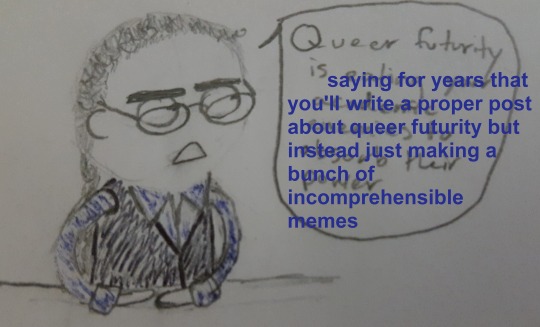
You’re welcome.
*****Do you think I’m frickin’ joking? Do you think this is a joke? This is not a joke. I’m so serious about crying about gum commercials.
******One of these days I’m going to write that post on queer time/ace time. It’s going to happen. I’ve said I’m going to write a post on queer futurity for years and years and now I’m finally writing it, so the queer/ace time post will happen one day. Just not today.
#asexual#ace safe#actuallyasexual#Carnival of Aces#queer ace#queer futurity#I have no idea what tags anyone's using anymore 笑#I barely remember what tags I use @___@#scattered leaking feelings ahoy since I procrastinated on writing this until the very last moment#and then cried while writing it but it's chill#it's a sad post but also a desperately sappy post#my trademark post style....#anyway I wrote this post while listening to 'The Future' by The Limousines if you want some vaguely appropriate background music#cross posted to the asexual agenda
106 notes
·
View notes
Photo

EDENDORDORADO ― Resonance of Paradise― HAMADARAKA Friday, August 31 ‒ Thursday, November 15, 2018
Glimpses of a vibrant utopia between reality and dreams Active both in Japan and abroad, Tokyo-based twin artist duo HAMADARAKA holds their first-ever major solo exhibition that showcases a visual feast of mystical fauna and flora DIESEL ART GALLERY is pleased to present “EDENDORDORADO: Resonance of Paradise,” the first-ever major exhibition in Japan showcasing the works of twin artist duo HAMADARAKA, from Friday, August 31 through Thursday, November 15, 2018. HAMADARAKA creates work inspired by their senses, sampling elements from their everyday surroundings, such as dreams, the temperature, the humidity, enduring images in their minds and the resonance of words. 434Hz, the theme for their body of work, is a frequency, between the two significant frequencies 432Hz and 440Hz, that the duo resonated with in particular. The exhibition features an as-yet unseen new installation, comprised of some 30 paintings and a floating sculpture, depicting a paradise inhabited by fauna and flora that have been awakened by the vibrations of the 434Hz frequency.
Conjured through the duoʼs impeccable teamwork, the paradise is home to a plethora of strange and mystical creatures and vegetation: A dense and massive stand of plants appears like a hologram in the darkness, with the effects of light and water. A translucent-bodied creature races across in undulating curves. Another creature emits flashes of rainbow light like the Brocken specter, stimulated by sounds by turns explosive and still. Their intermingling seems at times joyous, at others frightening. What appears before us, at first, seems like a distant world of the imagination, yet each creature with their charming faces and dynamic poses somehow instills a sense of familiarity and affinity in the viewer. This paradise ‒ where night and day, the inner and outer worlds, this world and the afterlife, dreams and reality collide ‒ emerges from the tremors of its inhabitants, and through its many facets, questions who we really are and where we stand in this world. There will be exclusive products featuring HAMADARAKAʼs work available, including earrings, rings, and a range of fragrances. An artist talk will be held on Saturday, October 27 from 6 to 7 pm with guests, artists Keiji Ito and Kosuke Kawamura.
ARTIST STATEMENT: At midnight, the throat of every living thing drew tight, Snakes that licked dreams then came and grazed their rainbow-colored eardrums with their cheeks A banana, its thudding heart melting into liquid gold Footsteps of lightening that just entered the world A teal-skied afternoon buzzing with the hazy-yet-transparent sounds of bumblebees The scent of pineapples dancing atop scorching waters that burn to look at In the darkness, plants emit flickers of light like ringing in the ears Nearby, a creature with its coat of rainbow spirals boomed Its blood smiled at a flashing light resonating at the frequency of 434Hz EDENDORDORADO EDENDORDORADO To our floating paradise
The theme for this body of work is “a paradise inhabited by fauna and flora awakened by sounds based on the 434 Hz frequency.” 434Hz is in between 432Hz, which is said to be in sync with our heartbeat, and 440Hz, the general tuning standard of which music based on its scale is said to induce feelings of excitement as well as aggression.
By shedding just a sliver of light, this paradise resounds like a piece of music (like awakening oneʼs dormant senses). Every sound, color and light is a living, breathing being, and the sounds they utter are the sounds of paradise ringing in our ears. We hope that they awaken something latent and subtle in everyone. HAMADARAKA (Eru and Emu Arizono)
CONCEPT
現実と夢の狭間に見え隠れする鮮彩なユートピア
神秘的ないきものたちの饗宴を描く
東京を拠点に国内外で活躍する双子のアートユニット、HAMADARAKAの初大型個展
DIESEL ART GALLERYでは、2018年8月31日(金)から11月15日(木)の会期で、双子のアートユニット、HAMADARAKA(ハマダラカ)の国内初大型個展「EDENDORDORADO(エデンドルドラド) ―楽園の物音―」を開催いたします。
HAMADARAKAは、夢、温度、湿度、記憶に残った図像、言葉の響き、ノイズなどの、身の回りの存在を五感で捉え、サンプリングすることによって作品を制作しています。
本展では、「432Hz」、「440Hz」という象徴的な二つの周波数の間の値であり、HAMADARAKAが共鳴した波長「434Hz」をテーマに、その振動により目覚めた生き物たちが織りなす「楽園」を描いたペインティング作品約30点と、ギャラリー空間に浮遊する立体作品からなる、未発表新作のインスタレーションを展覧いたします。
二人が阿吽の呼吸で生み出すその「楽園」には、光や水の効果により、暗闇に浮かび上がるホログラムのように巨大な植物が茂り、透き通った体の生き物がうねるような曲線で走りぬけます。 また、爆音と静寂の旋律により、ブロッケン現象のように生き物が虹色の閃光を放ち、不思議で神秘的な「ものたち」が数多く生息します。
それらが嬉々として、また時におどろおどろしく交ざり合う姿は、一見すると遠い空想世界のようでありながら、しかし、個々の愛嬌のある表情や生き生きとしたポーズは、鑑賞者に不思議な親近感と既視感を与えます。 「ものたち」が発するノイズによって浮遊し、昼と夜、内と外、この世とあの世、夢と現実が混ざりあうその「楽園」は、「そもそも自分は何者であるのか、どこにいるべき存在なのか」という問いを、多角的な視点から私たちに投げかけています。
ARTIST STATEMENT 喉が寄り添った真夜中に 夢をなめたへびたちが 虹色の鼓膜に頬ずりをした 黄金色に溶けだした 揺れるミバショウ*の心音 浮化したばかりの雷の足音 碧い昼間に振動する マルハナバチたちの透明な羽音 瞼がやけどするほどの水面に 踊るアナナス**の香り 暗闇に耳鳴りのように点滅する植物たちを横目に 虹色の螺旋の毛並みを轟かせ 434Hzの閃光に 血管たちが微笑した EDENDORDORADO EDENDORDORADO わたしたちの浮遊する楽園へ *ミバショウ=バナナ **アナナス=パイナップル 今回のテーマは、周波数「434Hz」の旋律により目覚めた生き物たちが織りなす「楽園」。 周波数「434Hz」は、私達人間の心臓に調和するとされている「432Hz」と、基本音とされているが人々を興奮させ、攻撃性を起こさせる音階とも言われている「440Hz」の間に存在します。 1mmの光をあてることで、眠っている感覚を呼び起こすかのように浮かび上がる旋律的な楽園。 すべての音、色、光は息する生き物であるように思います。その生き物たちが発する物音=いま私達に聴こえている“楽園の物音” が、たくさんの人の眠っている小さな何かを呼び起こすきっかけを創ることができたら嬉しいです。 (HAMADARAKA 有園絵瑠,絵夢)
会場では展示作品をはじめ、作品をモチーフにしたピアス、リング、マルチフレグランスなどの展覧会限定オリジナルグッズも販売いたします。
7 notes
·
View notes
Text
The Brow Beat Live Tour 2018 “Ragnarök” Urepia Report
[TRANSLATION] Witness the birth of the ‘Rockstar of the Next Generation’! The Brow Beat Live Tour Report
Release Date: 16 March 2018
Co-translated with @rz-jocelyn.
Please do not repost any of my translations.
You may also read this translation on my Wordpress here.
Popular Actor Sato Ryuji’s band project ventured on their first tour! Reporting on the situation.

Sato Ryuji, the highly sought after actor who has acted in stages to dramas, such as Musical ‘Touken Ranbu’ and Drama ‘Ochanomizu Rock’, started a band project called ‘The Brow Beat’ as the rock vocalist “Ryuji”.
The final performance of his first tour, ‘The Brow Beat Live Tour 2018 “Ragnarök”’ was held on 4 February at Tokyo’s EX THEATER ROPPONGI.
With PENICILLIN'S HAKUEI taking the approach of a total produce, the album “Ragnarok” was released in January; With this album in hand, the tour of the same name visited 4 cities around the country, and the tickets for all the performances were sold out on the very day [that ticket sales opened]. Waiting for the curtains to rise, the full house venue was filled with a sense of euphoria.
According to the appointed time, the lights darkened, and hands clapped in accompaniment as the screen showed the opening footage that was symbolic of the worldview of The Brow Beat. When the words “Are you ready” came into view, the venue was rocked with loud cheers.
The first [arrow that was] shot was “IRIS”, the first track on the album ‘Ragnarok’. With one breath, fans were drawn into the world of The Brow Beat by the pop-rock tune that was overflowing with a rushing sensation. The presence of [the person] smiling in front of the microphone stand as he sang a resounding long note with earnest…… This writer was extraordinarily surprised by Ryuji, who was so breathtaking that you would not think that this was his first tour. As if to say, “This live, it’s a “Ragnarok” on the existing music world!”, you could certainly feel that this was the birth of a new rockstar.

“Let’s have a blast!” (Ryuji)
At the explosion of sound and the burst of CO2 rising up [from the audience], with Ryuji’s scream as the signal, we moved to the up-tempo “Nippon”. Stretching out his body and leaning forward to the very edge of floor, Ryuji flashed a grin at the fans, as if he was enticing them [to join him], and blew them a kiss.
Going wild with abandonment, moving around on the stage freely and leisurely at his own pace, he seemed as if he was embodying the lyrics of “become the flower that would dye the era in colour” in his performance, and watching him, this writer was dumbstruck, thinking, “This is unbelievable, an incredibly mind-blowing rock vocalist has been born...!”
“Congratulations on the tour’s final performance! How you would like to enjoy yourself is completely up to you; for the people who would like to go wild, please go wild, and for the people who would like to completely focus and watch, please focus and watch; whichever way you would like to do it, in your own way, let's enjoy ourselves! Let's party and have blast!” (Ryuji)
From the Japanese-style romanticist rock number “Jisenoku” to the emotional “Scarlet Syndrome”...... following the up-tempo song with a song that was coloured in a different shade and had a drop [in tempo], the whole venue was enveloped by a passionate fervour that seemingly rose up [from the audience] all the way to the press area on the second-floor of the hall. Not to be outdone by the pumping fists in the air and the roaring shouts, Ryuji sang beautifully as he headbanged! The striking appearance of the audience and the artist that fed off each other’s energy was extraordinarily impressive.
The delicate sensitivity of the rock ballad “unlost” showed off the depth of Ryuji’s true strength as a vocalist. Without even [stopping for] an emcee, there was a 180 degree change in his worldview from the [songs that were like a] passionate, upbeat fierce attack just now, and he sang it at the top of his voice, and the whole venue was drawn into [his worldview]. It is often said that “songs are the heart [of the artist]”, and in his singing voice which expresses his “heart”, his backbone as an actor is beautifully alive.

In the emcee, with a cosy atmosphere [like] of a band with a long history, the supporting members, Narukaze (Guitar), CHIROLYN (Bass) and Kado Shuntarou (Drums), together with Ryuji, spoke of their thoughts about this tour.
“Ah, I don’t want it to end. Even though there weren’t many days, they were very fulfilling.” (Narukaze)
“I’ll do my best so that we can drink good beer at the afterparty! (laughs)” (CHIROLYN)
“Wow~~! There are so many people! I’ll do my best!!” (Kado Shuntarou)
Facing the members, Ryuji responded to them with a smile. From that expression that was full of respect for the members of this tour, it could be seen just how fulfilling this [experience] was [for him].
In expressing this feeling, he declared, “If this band gets to stand on a bigger stage, I’ll dye my hair pink!”, and with that, he performed the famous song “Pink Spider” by hide with Spread Beaver, which CHIROLYN is associated with. It was heartwarming to see that more than anyone else in the venue, it was Ryuji himself who enjoyed having the valuable opportunity to perform “Pink Spider” with CHIROLYN’s chorus and bass. For him [Ryuji] who has loved rock from his teens, it felt like hide, who valued and honoured young talent, was watching over him [Ryuji] from above, his smile and his singing voice.
The surprising setlist that was unique to the live still continued. HAKUEI made an appearance on stage as the guest vocalist, and he dropped [the song] “Kyousei Ecstasy” from the project that he supervises, “Litchi ☆ Hikari Club”. With the overwhelming aura of a rockstar and the flexible, new talent appearing together [on stage], the venue was drawn into a dirty and sexy world.
In the middle of it, there was a performance where HAKUEI took a hold of Ryuji's chin and made it look like he was about to kiss him, and amidst the powerfully intense theatrical staging, I could tell that the entire hall sucked in a breath.

“Tokyo, how’re you guys doing!? I can’t hear you!? That’s not loud enough at all!!”
Interposed between the member call time, the fans’ roaring screaming resounded, and the live at last headed towards the climax. Fitting [their voices] together, HAKUEI and Ryuji used all their energy and clashed together in the hard rock tune of “Black & Black” driving it into the skyrocketing whirlpool of passionate fervour in the hall.
Following this, in the Brow Beat’s hard metal number “Paranoid Star”, to respond to Ryuji, who was kneeling on the raised platform and shouting with all his might, fans were headbanging, and the audience was already thrown into chaos. I have already said this before but, with the especially vivid sense of unity and passionate fervour, you would not think that this was their first tour.

The last part of the actual performance was decorated with the song that had a positive message, “Browbeat”. With the shining and sparkling silver confetti, and the sound of Ryuji’s voice as he sang about the future [filling the hall], everyone in the venue reached catharsis. Ryuji turned the microphone towards the fans and asked the audience to join in for a call [and response]. With his smile, a smile that is different from the times that he shines brightly as an actor, he boldly takes on the challenge of bringing forth a range of expressions that are larger than life, and I get the impression that this is a representation of who he is, the person that is “Sato Ryuji”, who is becoming increasingly more alluring.


For the encore part, there was a unique experiment as they presented 3 covers arranged acoustically to entertain the audience.
“Everyone, do you believe in things like fate?” (Ryuji)
Chatting pleasantly with Narukaze, from such a shyly done song introduction, it seemed as if Ryuji's voice was tracing the world spun by the lyrics in the song that was sung, which was Kubukuro’s “Akai Ito”, capturing, in one fell swoop, the universal feeling of love that anyone would have. It was so impressive that the girls near this writer were wiping away tears in their eyes.
In Iruka’s “Nagori Yuki”, with a short break from one note to the next, he enthralled [the audience] with his singing that overflowed with emotions, [leading on to] the last [song], hide with Spread Beaver's “ROCKET DIVE”. With the sound of the fans’ clapping and percussion, and the acoustic guitar vividly colouring Ryuji’s voice, the venue was wrapped in a sense of euphoria.
Furthermore, on this day, to answer the excited cheering, there was also a double encore part! HAKUEI came on to the stage holding a bottle of champagne as a surprise for Ryuji, who had his birthday on the first day of this tour, and commented, “Today is the birthday of rockstar Ryuji!” The fans, who had been entranced by the acoustic part, had a burst in their rise in tension, as they surged into “Nippon” and “Black & Black”.
Up until the final note, striking to the end with everything that he had, his expression as he finished the last of the performance, the figure of Ryuji falling to his knees in that place, he was, without a doubt, a rockstar.
Saying “Let’s meet again!” and leaving behind an impish grin, even after Ryuji had left the stage, the venue was still full of excited commotion, clapping and elation. The charm of Sato Ryuji is no longer limited to the theatre or in front of the camera. It was like this that we witnessed a “Ragnarok” on the rock scene in 2018.

(Source: Urepia)
Today (3 May 2018) is the day of The Brow Beat’s special performance ‘Extra“Ragnarök”~Welcome to after party at Yaon’ at Hibiya Open-Air Concert Hall, which celebrates the success of their first sold out tour! ♡
38 notes
·
View notes
Text
Top 10 Halloween Horror Characters
Since it is now October I’ve decided to do a top 10 Horror character list. This will not necessarily include just villains. Also spoiler alert.
1. Carmilla from Carmilla by Joseph Sheridan and published in 1872. In the short story that predated Dracula by 25 years the main character is pursed by the vampire Carmilla who appears to be a beautiful young girl with an unfortunate habit of sleep walking. It isn’t until the end of the novella that it is revealed that Carmilla has been long dead, but was resurrected by an old lover.
2. Kazuyuki/Reiko Asakawa from Ring and Spiral by Koji Suzuki and published in 1991/1995. The main character of the first book in the Ring series Kazuyuki Asakawa works for a weekly magazine and is on his way home early one morning when he is drawn into a mysterious set of circumstances of sudden death among teenagers. One of the victims being his own niece. At the end of Ring it appears as though Asakawa has successfully put Sadako Yamamura to rest thus saving not only himself, but also his friend Ryuji Takayama and his wife and daughter. That is unfortunately not the case and on top of Takayama and his wife and child dying Asakawa is forced to create a mutated version of the Ring virus allowing Sadako another chance at revenge. He is last seen in the second book in the series Spiral and has is seen by the new main character in a hospital after a car accident in a catatonic state. He dies before the novel’s end. In both the 1998 Japanese film and the 2002 American version instead of being male Asakawa is female and is called Reiko in the Japanese and Rachel in the American. In the Japanese film Asakawa is portrayed by Nanako Matsushima and by Naomi Watts in the American.
3. Tomie from the manga series of the same name by Junji Ito which was published sporadically from 1987 until 2000. Tomie may have the face of an angel, but you don’t even have to finish the first chapter to realize that if she gets you in her sights your as good as dead. And as far getting rid of Tomie goes well....lots of people have tired, but she has this annoying little habit of every time someone kills her her life cycle is interrupted and she comes back for more. In the last chapter of the series it appears as though the two main characters have finally one upped this man eater by trapping her in a block of concrete which wouldn’t kill her, but when the block is finally broken open it is revealed that there has been a crack in it for years allowing Tomie to escape. Tomie has been portrayed by various actresses since 1998.
4. Cornelius Hickey from The Terror by Dan Simmons and published in 2007. A sailor aboard one of two ill fated British ships exploring the Arctic, Mr. Hickey as he is called by almost everyone would easy enough to overlook being one of the smallest men on the ships and having a rather ratty look about him. Despite these apparent disadvantages he is still able to garner enough support when it becomes obvious that neither ship is going to be able to get out of ice they’ve been stuck in over a year and has his followers resort to cannibalism in order to survive both the cold, dwindling supply of food, and the beast waiting for them. After all of his group including his lover die and Hickey is left alone he finally encounters the beast and realizes that he is not a God and is in fact just food for something else. In the 2018 television series Mr. Hickey was portrayed by Adam Nagaitis.
5. Tamsen Donner from The Hunger by Alma Katsu and published in 2018. Based partially on the ill fated Donner Party, Tamsen is the wife of the party leader and all though her beauty is envied by many she often thought of as a witch. As the party gets more and more lost Tamsen is one of the few members not to lose her head while trying to protect her children and wounded husband and is eventually helped by James Reed who had been banished previously. It is not revealed whether or not she survived. The real Tamsen Donner did not survive.
6. Mike Hanlon from It by Stephen King and published in 1986. The last member to join the Losers Club in 1958 while running from Henry Bowers and his gang and joins the rest of the group in a rock fight to chase Bowers off. Unlike the rest of the Losers Club instead of leaving Derry, Mike stays behind and starts working in the library and is the first one to realize that the murders are starting again. After gathering Bill, Ben, Beverly, Richie, and Eddie and finding out about Stan’s suicide it is decided that the only thing they can do to stop the murders is to kill It. Unfortunately Mike is unable to join his fellow losers after Henry who had escaped from the Juniper Hills asylum attacks him is hotel room, but still contributes the two silver bullets that wound It. After the murders have seemingly stopped for good Mike still remains in Derry and his memories of his fellow losers begin to fade again. In in the 1990 mini series Mike as portrayed by Marlon Tyler and Tim Reid and in the 2017/2019 films by Chosen Jacobs and Isaiah Mustafa.
7. Jud Crandall from Pet Semetary by Stephen King and published in 1983. Being introduced early in the story Jud and his wife Norma are the elderly neighbors to main character Louis Creed and Jud takes an immediate shine to him (no pun intended). Thinking they’ll just be taking a harmless walk together Jud shows the Creed family the Pet Semetary and inadvertently puts in motion the events that would destroy Louis and his family. After the deaths of Norma and Gage Creed in an effort to ease the pain of losing his son Jud mentions the Pet Semetary again to Louis, but warns him against it. Who would win in a fight? An undead toddler with a scalpel or an old man? Unfortunately in this case the toddler wins. In the 1989 film Jud was portrayed by Fred Gwynne.
8. I from Rebecca by Daphne du Maurier and published in 1938. We never do learn the name of the narrator of Rebecca, but not knowing her name doesn’t stop her from marrying a rich widower and moving into his estate Manderley After moving into her husband’s home ‘I’ is met with nothing, but suspicion and dislike. Most of it coming from the head housekeeper Mrs. Danvers who still keeps the bedroom of her deceased mistress immaculate. The second Mrs. DeWinters not only has the scrutiny of Mrs. Danvers to deal with, but also the persistent ghost of her predecessor Rebecca who is not resting easy in her watery grave. In the 1940 film the second Mrs. DeWinter was portrayed by Joan Fontaine.
9. Nadine Cross from The Stand by Stephen King and published in 1978. One of the numerous characters in the sprawling 1400+ page novel one of the reasons Nadine Cross sticks out is because she has the unfortunate fate of becoming the bride of Randall Flagg and having his son; a fate she seems to at times embrace and other times shrink from. I guess a side effect of finally meeting your fiancee can be having your hair turn completely white. After traveling to meet Mother Abigail with Larry’s group Nadine is finally rejected by him and seeks comfort from Harold Lauder who she eventually leaves to die on the side of the road. Finally arriving in Las Vegas with her new husband Nadine escapes from Flagg in a permanent and violent way by goading him into throwing her off the top of a high rise hotel. This is of course after he realizes that she is pregnant with his child. In the 1994 mini series Nadine is portrayed by Laura San Giacomo.
10. Tad Trenton from Cujo by Stephen King and published in 1981. One of many child characters in King’s huge body of work, but one of the few to die Tad was spared his grisly fate in the movie, but wasn’t so lucky in the book. The adored young son of Vic and Donna Trenton, Tad’s only problem is the monster in his closet. Or so he thinks. When Vic leaves for a business trip Tad and Donna head to a family owned garage to get her car repaired only for the little boy to realize that the monsters aren’t always contained in closets. When the little boy and his mother are stuck in the hot car for days Donna eventually breaks out of the car and beats the rabid Cujo to death only to realize that Tad has died in the meantime of heatstroke and dehydration. In the 1983 film Tad was portrayed by Danny Pintauro.
#halloween#horror characters#carmilla#kazuyuki asakawa#reiko asakawa#tomie#Cornelius hickey#tamsen donner#mike hanlon#jud crandall#mrs dewinter#nadine cross#tad trenton
4 notes
·
View notes
Text
Issues With Trials By Zoom
By Jonathan Cheng, Rice University Class of 2024
February 19, 2021
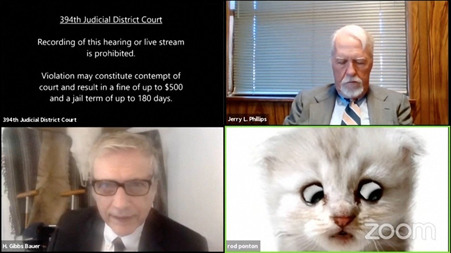
A Texas lawyer recently went viral after an embarrassing mishap during a recorded Zoom trial. While representing the state of Texas in a hearing concerning contraband products leaving the US, lawyer Rod Ponton suddenly transformed into a baby-eyed cat. Hilarity ensued, with Ponton attempting to remove the filter and reassure the judge that he was, in fact, not a cat. The presiding judge, Roy Ferguson, of Texas’s 394th judicial district, later shared the video on social media (Guardian). But this incident highlights existing questions and concerns that many have had about the prospect of transitioning this nation’s judicial system into an online format.
There are several pressing issues that immediately surface when considering the idea of a “trial by Zoom”. First and foremost, there is the problem of due process and equality under the law that is a cherished institution in this country. Under the 6th Amendment, “In all criminal prosecutions, the accused shall enjoy the right to a speedy and public trial, by an impartial jury of the State and district wherein the crime shall have been committed” (Constitution Center). Zoom presents several obstacles to the idea of an impartial jury. There is the fact that many Americans do not have access to technology, which severely limits jury selection and raises the possibility of a trial only by Americans with the income to afford personal devices. In 2019, almost 1 in 5 Americans did not own a smartphone, 1 in 4 Americans did not own a laptop, and 1 in 10 Americans did not use the internet at all (Pew Research Center). With physical trials in a courtroom, there were few legitimate hurdles preventing lower income Americans from attending court and doing their civic duty as a juror. This is not the case in the age of Zoom.
Online trials may also affect the equality of proceedings for the witnesses and the jurors themselves. Witnesses may find it far easier to commit perjury while under examination from the safety of their own home, with a video screen separating them from any hostile interrogator. It is far easier to tell a lie when you are not physically seated on the wooden bench of the stand, staring at an aggressively probing attorney and twelve jurors listening intently to every detail of your story. Jurors may also have a different trial experience from the comfort of their own homes that may impact their ability to remain impartial. Both the defendant and the witnesses could appear impersonal and alien to the jurors, causing them to feel far less sympathy towards them. Jurors could be distracted by interesting Zoom backgrounds, or even by scrolling through their phone or checking their emails on their computer (Institute for Legal Reform), presenting a new problem compared to physical trials where cell phones and other devices are strictly discouraged as potential distractions. Technical issues could also frustrate jurors and disrupt their ability to focus on proceedings. During a criminal jury trial on August 11th, 2020, “Several jurors could not see the defense attorney when he first began his voir dire, so the proceedings had to stop in order for the court to teach the jurors how to switch from Gallery View to Active Speaker. Lots of questions had to be repeated because of bad connections or an audio lag. Poor connectivity caused visual and audio problems multiple times throughout voir dire, which led to people talking over one another. One juror had to move locations during jury selection (for reasons unknown), which was very awkward and caused yet another delay” (Law.com). Forcing jurors to embarrassingly flounder through an unfamiliar process by themselves can lead to them becoming flustered and less likely to sympathize with the defendant or properly engage in proceedings. Everything is obviously different now, from business meetings to everyday life, during the pandemic. But any significant change to procedure, like for instance the wholesale altering of the medium of trials across the US, is immediately a gross injustice under the 6th Amendment to all defendants who are now expected to fight for their lives and livelihoods in a system that is completely different from the one their predecessors faced.
This persisting problem of technical difficulties is multi-faceted. It must be remembered that this level of disruption caused by technical difficulties is rare in an ordinary courtroom (Grabowski). The increasing number of antics and mishaps that have occurred on Zoom trials, while hilarious to watch on social media, can create a lack of seriousness in the proceedings. Examples range from Ponton’s issue with the cat face (Guardian), to lawyers having mic issues, being intruded on by others members of the household, or struggling to change inappropriate backgrounds. Obviously, many of these issues are unavoidable due to the pandemic and the unique difficulty that working from home poses, however it cannot be denied that Zoom trials are having a detrimental effect on the reputation of the US justice system. Courts are supposed to inspire a degree of formality and authority; that’s why courthouses are normally some of the most centrally located buildings in cities, why the Supreme Court building looks as imposing as it does, why witnesses have to swear an oath before testifying, and why judges wear their official robes and sit in high chairs above everyone else (ClearWay Law). It must be remembered that courts are powerful institutions, capable of dealing out punishments and jail sentences that can change a person’s life forever. Imagine how it must feel as a defendant to watch your trial proliferate across all of social media, with your defense lawyer and presiding judge cracking up and your prosecutor looking around confusedly with a cat face on, when you are on trial for your life. Conducting trials by Zoom and running the risk of amusing technical difficulties removes some of the power and gravity that was previously invested in the US court system.
A problem also exists with the ability of courtroom trials to be recorded and live streamed in a way that they were never able to be before. Judges and legal scholars have long been opposed to the presence of cameras in the courtroom, alleging that they “distract trial participants, prejudice trial outcomes, and thus deprive defendants of fair trials” (Strickland). In addition, having cameras pointed directly in people’s faces can cause a shy witness to fidget, sweat, and appear uncredible, or encourage egotistical lawyers to become overly dramatic and showy. This is the reason why there are still dedicated artists that create courtroom sketches, in order to provide the public with a view into the courtroom while still maintaining some decorum. When the decision was made by Judge Lance Ito to televise O.J. Simpson’s trial, it was met by significant controversy and backlash in the legal community, who objected to the prejudicial presence of cameras in such a high-profile case (Lowry). Obviously, with Zoom, it is impossible not to have cameras pointed in your face at all times or avoid their prejudicial effects. And there are significant potential negative consequences to this. Trials can be recorded, live streamed, or posted online with ease now due to their online nature. This can lead to privacy concerns for both parties in a trial who may not want the entire world knowing their business. For example, tech-savvy children could conceivably find ways to watch footage of their parents’ nasty divorce or heinous crimes that they are not ready to emotionally handle. Hackers can potentially gain access to sensitive material that is made available in court, such as birth dates, valuable evidence, signatures, or social security numbers (National Law Review). Given the painstaking effort in the past by lawyers and judges to ban cameras, maintain privacy, and ensure complete impartiality, it is surprising that all of these pretensions have been tossed out the window with Zoom trials.
Of course, as long as the pandemic continues, trial by Zoom is something that must continue in order to preserve the safety of all parties involved. But it is worth at least considering the plethora of issues that are presented by the idea of making a potentially life-changing decision over someone else while sitting in the comfort of your own home, dialing in on a video screen.
______________________________________________________________
“Court Can Be A Scary Place- A Law Student Story.” ClearwayLaw, 23 Nov. 2018, https://clearwaylaw.com/court-can-be-a-scary-place-a-law-student-story/.
“First Asbestos Trials on Zoom Marred by Distracted Jurors and Technical Problems.” ILR, 19 Aug. 2020, https://instituteforlegalreform.com/first-asbestos-trials-on-zoom-marred-by-distracted-jurors-and-technical-problems/.
Mark Grabowski, Are Technical Difficulties at the Supreme Court Causing a "Disregard of Duty"?, 3 Case W. Res. J.L. Tech. & Internet 93 (2011)
Jouvenal, Justin. “Justice by Zoom: Frozen Video, a Cat — and Finally a Verdict.” Washington Post. www.washingtonpost.com, https://www.washingtonpost.com/local/legal-issues/justice-by-zoom-frozen-video-a-cat--and-finally-a-verdict/2020/08/12/3e073c56-dbd3-11ea-8051-d5f887d73381_story.html. Accessed 16 Feb. 2021.
Lapinski, Jennifer, et al. “Zoom Jury Trials: The Idea Vastly Exceeds the Technology.” Texas Lawyer, https://www.law.com/texaslawyer/2020/09/29/zoom-jury-trials-the-idea-vastly-exceeds-the-technology/. Accessed 16 Feb. 2021.
Lowry, Brian, and Brian Lowry. “O.J. Simpson Trial Ruling to Let TV Cameras in Court Created 20-Year Mess.” Variety, 18 June 2014, https://variety.com/2014/tv/columns/judge-itos-decision-to-let-cameras-in-the-courtroom-20-years-ago-has-created-a-mess-1201222205/.
NW, 1615 L. St, et al. “10% of Americans Don’t Use the Internet. Who Are They?” Pew Research Center, https://www.pewresearch.org/fact-tank/2019/04/22/some-americans-dont-use-the-internet-who-are-they/. Accessed 16 Feb. 2021.
---. “Demographics of Mobile Device Ownership and Adoption in the United States.” Pew Research Center: Internet, Science & Tech, https://www.pewresearch.org/internet/fact-sheet/mobile/. Accessed 16 Feb. 2021.
Schiffer, Zoe. “The Jury Is Still out on Zoom Trials.” The Verge, 22 Apr. 2020, https://www.theverge.com/2020/4/22/21230022/jury-zoom-trials-court-hearings-justice-system-virtual-transparency.
Strickl, Ruth Ann. Cameras in the Courtroom. https://www.mtsu.edu/first-amendment/article/989/cameras-in-the-courtroom. Accessed 16 Feb. 2021.
Texas Lawyer, Trapped by Cat Filter on Zoom Call, Informs Judge He Is Not a Cat | Texas | The Guardian. https://www.theguardian.com/us-news/2021/feb/09/texas-lawyer-zoom-cat-filter-kitten. Accessed 16 Feb. 2021.
“The 6th Amendment of the U.S. Constitution.” National Constitution Center – The 6th Amendment of the U.S. Constitution, https://constitutioncenter.org/interactive-constitution/amendment/amendment-vi. Accessed 16 Feb. 2021.
“The Pros and Cons of Zoom Court Hearings.” The National Law Review, https://www.natlawreview.com/article/pros-and-cons-zoom-court-hearings. Accessed 16 Feb. 2021.
“What To Expect at a Virtual Hearing.” Michigan Legal Help, 27 Apr. 2020, https://michiganlegalhelp.org/self-help-tools/going-court/what-expect-virtual-hearing.
0 notes
Text
SOCIAL MEDIA AND FRIENDSHIPS WITHIN YOUNG PEOPLE
Research shows that “social interactions via social media play a growing role in leisure time of young people and have changed the traditional patterns of friendship-driven social interactions among peers.” Face to face interactions have gradually been replaced with interactions on social media. Less young people are interacting face to face these days. “Friendships play a huge apart of young peoples lives as they “gather life experiences” (Jean Philippe Décieux, Andreas Heinen, Helmut Willems,2018). For example create memories and experiences in ones life. “In order to successfully get along in peer group settings and to form deeper relationships, young people have to cultivate social skills (e.g., communication, empathy, ability to balance own needs with needs of another person, morals, listening and observing)” (Tillery, Cohen, Parra, Kitzmann, & Howard Sharp, 2015). The use “new media, especially social media and instant messaging services, facilitate and change communication among peers” (Lenhart, Smith, Anderson, Duggan, & Perrin, 2015).
Young people are “earlier adopters of digital communications”, therefore they have spent most of their lives with social media. “Hence, the increase of online communication in modern societies raises questions regarding its impact on young people’s patterns of social interactions as well as on identity formation of this ‘digital generation” (Buckingham, 2008: 12; Ito et al., 2010). It is believed that young people feel social isolation during offline interactions. However, “online interactions do not completely replace offline interactions”(Jean Philippe Décieux, Andreas Heinen, Helmut Willems,2018). For example, a recent studied conveyed “that most online connections are based on offline networks and that offline interactions are not substituted but rather complemented by online interactions” (Döring, 2010). This suggests that most young people are interacting with people who that maintain offline interactions with. Online interaction can be used to strengthen offline interactions.
A ‘trend survey’ was conducted in Luxembourg , 2008 which explored how young people spend their free time. “In 2008, ‘meeting up with friends’ was ranked as the most important activity”(Jean Philippe Décieux, Andreas Heinen, Helmut Willems,2018). In 2016 the same survey was conducted ,however, the “rank order changed considerably, whereas the activities ‘listening to music’ and ‘internet’ remained at the top, meeting up with friends’ sharply decreased”(Jean Philippe Décieux, Andreas Heinen, Helmut Willems,2018). In the same survey "relaxing alone became more and more important” and was ranked fifth which was high then ‘meeting up with friends’” (Jean Philippe Décieux, Andreas Heinen, Helmut Willems,2018). This suggests that “meeting friends in person has become less important for the interviewed young people, whereas spending time alone has become a more common leisure activity among them” (Jean Philippe Décieux, Andreas Heinen, Helmut Willems,2018). Research shows that “three out of four (76.1%) young people stated that they very often or often use the Internet ‘to interact with others’ or ‘to stay in contact with others’”(Jean Philippe Décieux, Andreas Heinen, Helmut Willems,2018). Young people tend to use online interaction often as it requires less effort than offline interactions. “Young interviewees also specified that social media interactions are very comfort- able for them as they can interact with their friends while they are doing other things”(Jean Philippe Décieux, Andreas Heinen, Helmut Willems,2018) They “are connected to social media tools and by this to their peers ‘anytime and anywhere’”(Jean Philippe Décieux, Andreas Heinen, Helmut Willems,2018).

Young people tend to be interacting with their friends constantly on social media. Social media allows them to “share their life and experiences” on these sites which allows them too “exchange news immediately with their peers and do not have to wait until they meet them in person”(Jean Philippe Décieux, Andreas Heinen, Helmut Willems,2018) . However, “meeting people in person and to interact offline are considered to be important prerequisites to develop friendships”(Jean Philippe Décieux, Andreas Heinen, Helmut Willems,2018) . Research suggests that many “social media interactions are strongly linked to the offline daily life” of these young adults (Jean Philippe Décieux, Andreas Heinen, Helmut Willems,2018). Most online interactions are with people they have met offline and “most young people see social media activities not as integral for their friendship, but as a simple and easy opportunity for friendship-driven actions and to strengthen bonds of existing friendships” (Awan & Gauntlett, 2013; Boyd, 2008b).
This piece of research has conveyed that young people feel the need to meet up with each other less as they are constantly connected with each other at all times. It is clear that most of these online interactions are with offline friendships. Research also states that young people still like to meet friends offline. However, it is happening less and less. Communicating online is quick and requires a minimal amount of effort. Young adults are constantly connecting with their friends online which suggests that there is not much to say when meeting offline. Do these online interactions ruin communication with offline interactions?
All references and sources from:
Jean Philippe Décieux, Andreas Heinen, Helmut Willems,2018,Social Media and Its Role in Friendship-driven Interactions among Young People: A Mixed Methods Study,27(1) 18–31,[Accessed,09,January,2020]
0 notes
Text
Crunchyroll Adds "DARLING in the FRANXX" to Winter Anime Season, Plus Six More Titles
A new anime season is nearly upon us, and Crunchyroll is rolling out a bundle of new announcements for their Winter 2018 simulcast line-up. Let's see what's coming soon to an online streaming platform near you:
DARLING in the FRANXX
An original science fiction TV anime with direction by Atsushi Nishigori and animation by TRIGGER (Kill la Kill) and A-1 Pictures (Interviews with Monster Girls), Crunchyroll describes DARLING in the FRANXX as follows:
They dream of one day flying into the endless sky, even though they are painfully aware of how far away the sky is beyond the glass that blocks their flight.
The distant future: Humanity established the mobile fort city, Plantation, upon the ruined wasteland and civilization flourished. Within the city were pilot quarters called Mistilteinn, otherwise known as the “Birdcage.” That is where the children live... Not knowing anything of the outside world, and unaware of the vast sky. Their only mission in life was the fight.
Their enemies are the mysterious giant organisms known as Kyoryu. The children operate robots known as FRANXX in order to face these still unseen enemies because they believe that is their purpose in life. Among them was a boy who was once called a child prodigy: Code number 016, Hiro. However, now he’s a failure and considered unneeded. Those who cannot pilot FRANXX basically do not exist.
One day, a mysterious girl called Zero Two appears in front of Hiro. From her face grew two alluring horns.
“I’ve found you, my Darling.”
Territories: TBA.
Death March to the Parallel World Rhapsody
Based on the popular "isekai" ("alternate world") light novel series written by Hiro Ainana and illustrated by shri, Death March to the Parallel World Rhapsody is directed by Shin Ōnuma and features animation by Silver Link (Restaurant to Another World) and Connect. Crunchyroll describes Death March to the Parallel World Rhapsody as follows:
youtube
“Satou,” aka Ichiro Suzuki is a programmer in the middle of a death march. He was supposed to be taking a nap but somehow wakes up in another world... What lies before him is what looks like the menu screen of the game he was working before his nap. He’s at a complete beginner stage at level 1. However, he had the option to “explore the whole map,” which was just implemented to help out new players and three “Meteor Showers” which could level a whole map. Suddenly, a whole group of lizardmen appear in front of him. In order to survive, Satou uses Meteor Shower, his level jumped to 310 and he became extremely wealthy. Whether it be dream or reality, Satou’s journey was now beginning.
Territories: TBA.
Katana Maidens ~ Toji No Miko
An original TV anime with direction by Kōdai Kakimoto and animation by Studio Gokumi (KINMOZA!), Crunchyroll describes Katana Maidens ~ Toji no Miko as follows:
Since the ancient times, the Kannagi priestesses have used their swords, or Okatana, to exorcise the creatures known as Aratama that brought chaos upon the world of man. These maidens were known as Tojis. They are a special task force within the police. They are allowed to have their Okatana on their person because they are government officials, but they mostly consist of middle school and high school girls who go to one of five training schools throughout the country. Though they mostly live normal school lives, if they are given a mission, they take their Okatana and unleash their powers, fighting to protect the people.
youtube
This spring, the top Tojis from five schools across the country have been gathered for a customary tournament where they will use their abilities and fight for the top position. As the many Tojis trained and prepared for the upcoming tournament, there was one girl who was even more determined than the others on improving her swordsmanship. What lies before the end of her Okatana?
Territories: Worldwide, except Asia.
citrus
Based on the yuri manga by Saburouta, citrus is directed by Takeo Takahashi and features animation by Passione (Hinako Note). Crunchyroll describes citrus as follows:
youtube
Yuzu, a high school gyaru who hasn't experienced her first love yet, transfers to an all-girls school after her mother remarries. She's beyond upset that she can't land a boyfriend at her new school. Then, on her first day, she meets the beautiful black-haired student council president Mei in the worst way possible. What's more, she later finds out that Mei is her new step-sister, and they'll be living under the same roof! And so the love affair between two polar opposite high school girls who find themselves drawn to one another begins!
Territories: Worldwide, except Asia.
Junji Ito Collection
Crunchyroll delves into spooky territory with this collection of terrifying tales based on the works of macabre manga master Junji Ito. Junji Ito Collection is directed by Shinobu Tagashira and that features animation by Studio Deen (Showa Genroku Rakugo Shinju), and Crunchyroll describes it as follows:
youtube
The works of one of the most famous Japanese horror manga artists, Junji Ito, finally gets animated! This will be an omnibus animation where each episode will star different protagonists such as the famous Tomie, Soichi, and Fuchi!
Territories: Worldwide, except Asia.
Basilisk: The Ouka Ninja Scrolls
Based on the novel by Masaki Yamada that continues the story of Masaki Segawa's Basilisk ninja manga series, Basilisk: The Ouka Ninja Scrolls is directed by Junji Nishimura and features animation by Seven Arcs Pictures (TRINITY SEVEN). Crunchyroll describes Basilisk: The Ouka Ninja Scrolls as follows:
The battle for succession that continued for three generations of shogun in the Keichou era culminated in a gruesome battle of ninja arts between the Kouga and Iga clans. Amidst a rain of flower petals, a man and woman who had decided to live for love were separated once again, beautiful in their transience.
youtube
However, it is said that by the hand of Hattori Hanzo's adopted son, Kyouhachirou, these two flower petals, whether temporarily or permanently, were given life again and left two mementos behind. These children, born with a destiny of their own, were called Kouga Hachirou and Iga Hibiki. The former had eyes like his father's, and the latter had eyes like her mother's.
It is now the Kan'ei era, and the land is at peace. As ninjas begin to disappear into the shadows after being deemed unnecessary, The Kouga and Iga clans ask a favor of Hachirou and Hibiki in hopes of reinforcing their foundations.
Territories: Worldwide except Asia, the Middle East, and North Africa.
Hakata Tonkotsu Ramens
Crunchyroll descends into the criminal underworld of Fukuoka with this adaptation based on the series of crime novels written by Chiaki Kisaki and illustrated by Hako Ichiiro. Hakata Tonkotsu Ramens is directed by Kenji Yasuda and features animation by Satelight (The Disappearance of Nagato Yuki-chan), and Crunchyroll describes its story as follows:
"There is a person you desperately want to kill. Now, how do you kill that person?"
youtube
At a glance, Fukuoka seems like a peaceful town, but crime runs rampant behind the scenes. It's now a battleground for professional killers, with urban legends suggesting that there's even one who specializes in killing professional killers. Assassins, detectives, revenge seekers, informants, torture specialists... When stories are told of these and other professionals of the underground, a "killer of professional killers" appears...
The winner of the 2013 Dengeki Novel Prize (Grand Prize) is now an anime!
Territories: Worldwide, except Asia.
We've got something to satisfy even the most serious anime appetites, and there are more announcements still to come, so stay tuned for additional updates on Crunchyroll's Winter 2018 simulcast season!
Paul Chapman is the host of The Greatest Movie EVER! Podcast and GME! Anime Fun Time.
2 notes
·
View notes
Text
All the Tiny Spaces Belong to Japan!

While the Japanese have been stereotyped as an overworked, falling-asleep-on-their-feet kind of people, what they’ve actually built is a way to coexist with each other while maintaining the efficiency of Japan’s modern cities. Downsizing dwellings has been the name of the game and it is now becoming increasingly common in places like Tokyo for adults (and sometimes even small families) to live in residential units that measure just 9.46 square meters or even less. The miniaturized dwellings may not be for the claustrophobic, but they are cheaper to rent and they provide the essentials of what you need: a place to sleep, and a place for all your stuff. The channel Living Big in a Tiny House sums up how you can “live big” despite having limited dwelling space. You organize your stuff well enough, you don’t buy stuff you don’t need, and you perfect creating just the right spaces for the things that you need to do. The resident in the episode above is from Australia and she’s still pretty happy despite the drastic shift from a regular-sized dwelling to a miniaturized one that just contains the essentials. Japan has long practiced downsizing of houses because of the soaring cost of real estate, and as you may already know, not everyone can shell out millions of yen to buy a house. So tiny house living was a logical option, and the current trend now is for small rental units to be small, but compensating with height as many of them have lofts. This tiny home in the heart of Tokyo is the size of a garage, and a couple lives in it. It has all of the modern amenities that one could ask for, albeit in a very downsized fashion. It was designed like a traditional Japanese home, with a shoe-changing area when you enter the vestibule. A massive French window allows natural light to stream in, illuminating the central spaces of the house. The French window also gives the tiny home the illusion of additional space by “merging the outside” with what is inside. By putting a large window that faces the street, the small house feels less claustrophobic. The owner states that the small plot of land where their tiny home stands is all they can afford to buy, which explains why they settled for the special, one-story house. The husband proudly presents their collection of full-sized vinyl records, which just shows that no matter how small your space is, there is always space for your passions in life. Japanese master craftsman Tagami Haruhiko is well-known for his dream project: creating the very first full-sized house on wheels. While mobile campers and RVs have been common in the United States for decades, the concept of the crafted “small home” is a truly Japanese invention. Tagami’s creations are made of a variety of materials (but build predominantly with wood) and were initially intended to be upscale camping units. Later on, the master craftsman decided to expand his vision and create true homes that can be hitched to cars and trucks and brought wherever the owner wishes to be. Tagami’s creations weigh an average of just 500 kilograms. The craftsman is proud that with his design, an owner of such a home can park in a regular parking slot and drive across narrow country roads with no problems at all. View this post on Instagram A post shared by Angela Bailey (@bails.at.large) on Jun 19, 2018 at 3:49pm PDT Going vertical is the name of the game, and being able to fit more people into a limited space has been addressed by moving things up, literally. A 9.46 square meter rental unit costs around ¥66,500 ($607), excluding utilities and other fees. Ito, an IT engineer living in Tokyo, says that “so far it’s been comfortable. I keep my belongings to a bare minimum, and it’s easy to get around since everything is literally within arm’s reach. It gets cramped when friends visit, however. One person has to sit on the floor, while another goes up to the loft.” View this post on Instagram A post shared by Dearly Desiana / Ibu Jari 👍🏼 (@dearlydjoshua) on Mar 29, 2016 at 1:56am PDT The strategic shrinking of living spaces extends to hotels themselves. Capsule hotels abound in Japan, especially in busier cities like Tokyo, near airports. Capsule hotels offer an alternative means of accommodation to travelers who are just staying the night in a city, and plan to travel the next day. They’re more cost-effective, definitely no-frills, and they are extremely popular especially to backpackers and global tourists who want to see more of the country at lower cost. Read the full article
0 notes
Text
It’s been hard out here for the NFL’s bird teams

Carson Wentz and the Eagles are off to a disappointing start to 2019.
The Eagles and Falcons have major questions to answer after a particularly bad week for our avian friends. And what’s up with the Cowboys’ slow starts?
Birds have had a rough go of it lately. To be honest, they’ve had a rough go of it since 1970, but none of us want to think too hard right now about how North America has lost 3 billion birds in five decades. We’ll leave the panic index for football matters because everything else can be too overwhelming.
This past Sunday, all five bird teams lost in the same week for the first time in at least a decade (there was one week in 2012 when they went 0-3, with two on byes). For some, it was business as usual (sorry, Cardinals). For others, it was their first loss of the year and wasn’t that big of a deal anyway. The Ravens fell on the road to the Chiefs and learned a valuable lesson about themselves, while the Seahawks always manage to get things figured out by the time December rolls around.
It was a little more concerning for the Falcons and Eagles, two teams that entered the season as possible contenders and are just 1-2 through the first three weeks.
Those aren’t the only teams we’re checking in on this week, though. I guess you could say the new panic index isn’t just ... for the birds.
The Eagles are tearing their fans apart!
Eagles fans, bless them, are a passionate flock. This is something we knew last year, when they booed the defending championship exactly one half into the new season. This is something we knew months before that following their Super Bowl victory. Hell, this is something we knew before many of us were even born.
So when the Eagles — a team some were picking to make it to Super Bowl 54 — dropped a home game to the Lions, the fans were unsurprisingly upset.
That includes everyone from an Ivy League dean of admissions:
Can’t stop watching this irate Eagles fan. pic.twitter.com/yzA3DYCgfJ
— Will Brinson (@WillBrinson) September 22, 2019
To a baby-saving hero:
Eagles fans have no chill In the middle of an eyewitness describing how people were saving babies out of a burning building, this fan brings up Eagles drops on @NBCPhiladelphia pic.twitter.com/RCLG5ZdNzw
— John Clark (@JClarkNBCS) September 23, 2019
Go birds.
The Eagles’ lone win of the season so far came against the still-winless Washington, the current betting favorite as the first team to fire its coach. Oh, and Philly was losing that game 17-0, only to rally for a five-point victory — at home.
On the other hand, the Eagles aren’t that far off from being 3-0 either. The margins in their two losses were close: four points to the Falcons on the road, and three points to the Lions. They could’ve won both games on their last possession, and maybe should’ve, if not for self-inflicted wounds like drops and penalties. They are also dealing with so many injuries that they canceled practice one day last week.
Still, Philly is two games back of Dallas in the NFC East standings, and the schedule doesn’t get any easier from here. In the next five weeks, the Eagles hit the road four times: against the Packers, Vikings, Cowboys, and Bills. Through Week 3, those teams are a collective 11-1.
Panic index: You know who else lost to the Lions in Week 3 to slip to 1-2? The 2018 Patriots. Maybe the jawn isn’t falling after all, Eagles fans. There’s still time to turn things around.
Here we go again with the Falcons
Following a disappointing 7-9 season last year, Atlanta was expected to bounce back in 2019 — perhaps even as a potential Super Bowl contender. Its potent offense — featuring the consistently underrated Matt Ryan and the NFL’s best WR, Julio Jones — returned with several new offensive linemen, and the defense was finally healthy again.
But early on, the Falcons look more like the same team from 2018, with injuries and penalties piling up and a lack of cohesion on offense. The Falcons are one of the most talented teams in the NFL, but they just can’t get out of their own way.
In Week 3, they lost to the Colts 27-24 on the road and despite clawing back, Atlanta couldn’t overcome a 20-3 first-half deficit. The bigger problem is how the Falcons keep falling into those holes, mostly due to undisciplined play. From The Falcoholic:
Mental errors are becoming far too common on a weekly basis for the Falcons. You can’t be dependent on converting third and long situations at a staggering rate every week. These careless, unforced penalties will usually come back to haunt any team.
Most of the biggest penalties were committed by the defense. On 16 penalties, the Colts picked up seven first downs.
The Falcons had a lengthy list of injuries after the game, none more costly than safety Keanu Neal’s season-ending Achilles tear.
Offensively, the entire unit is essentially being driven by Jones. Through three games, Jones has four touchdowns, and is averaging 88.3 yards per game. In fact, the Falcons wouldn’t even have a win this season if not for Jones’ superhuman efforts.
Ryan has done a good job of finding Jones when he needs to, but he’s almost thrown as many interceptions this year (six) as he did all of 2018 (seven), which certainly doesn’t help production on offense. Second-year receiver Calvin Ridley is also seeing a curious lack of targets, getting just one against the Colts.
The run game has to get a lot better than it has been early on, too. Devonta Freeman has just 129 yards and no TDs through three weeks. Backup running back Ito Smith has just 11 carries and is concussion protocol. That’s a lot of pressure to put on Ryan and the passing game week in and week out.
Right now, this feels a lot like the same old Falcons.
Panic index: Atlanta’s slow start is particularly concerning given who it has left on the schedule, which includes road trips to Houston and New Orleans, and home games against. the Rams and Seahawks. The offense has time to work out the kinks, and should be able to, based on its strong second half against the Colts.
But if the Falcons can’t clean up their mistakes, they could be out of the NFC South race quickly.
Slow starts are going to eventually bite the Cowboys in the butt
The Cowboys opened the season with an easy three-game slate against the Giants, Washington, and the Dolphins. They’re 3-0 and those three opponents are 1-8, collectively.
Dallas is averaging just over 32 points per game and is allowing just under 15. Everything is peachy keen, except the Cowboys looked pretty shaky early against the tanking Dolphins. At halftime, Miami trailed 10-6 and were even in position to take the lead before Kenyan Drake fumbled inside the Cowboys’ 10-yard line.
Eventually, the Cowboys — who are much, much more talented than the Dolphins — figured things out and cruised to a 31-6 win.
But Dallas had similar issues in the first two weeks. Both New York and Washington scored first to take 7-0 leads against the Cowboys, who then straightened themselves out in and won by double digits each time.
Those slow starts could become a problem, though, and soon. Dallas will face the 2-1 Saints and the 3-0 Packers in the next two weeks and can’t afford to keep stumbling out the gates. It won’t be as easy to pull off a comeback against actual contenders.
Panic index: The second quarter has been Dak Prescott’s best quarter over the course of his NFL career so far. He’s thrown 30 of his 76 career touchdowns in the second quarter compared to just 13 touchdowns in the first quarter. That lends some credence to the idea that the Cowboys have a slow-start problem.
Dallas is doing its best work in the third quarter in 2019, but thrived in the first quarter last year. There’s still plenty of time to channel its 2018 self and get out to faster starts.
Marcus Mariota’s not getting that nine-figure contract extension
Mariota’s been a mercurial figure through four-plus seasons with the Titans. The former No. 2 overall pick has guided Tennessee to winning records in each of the past three years and even has a playoff upset under his belt. He’s also never played a full 16-game schedule, ranked higher than ninth in the NFL in passing efficiency, or been selected to a Pro Bowl roster.
That pendulum swung hard to the negative side in Week 3. Mariota couldn’t find his footing on a rainy night in Jacksonville, throwing for 304 yards but needing 49 dropbacks to get there. He didn’t reach the end zone, but he was sacked nine times behind an offensive line that desperately misses Taylor Lewan (currently serving a four-game PED suspension).
The Titans only scored once in a 20-7 loss that dropped them to the bottom of the AFC South’s pecking order. They’ve totaled just 24 total points since their opening week upset of the Browns in Cleveland.
Once again, Tennessee faces a season in purgatory. The Titans are occasionally good enough to strike fear in the hearts of actual Super Bowl contenders, but not the kind of threat that can make noise beyond the first weekend of the postseason.
The source of the frustration and the heart of the team’s “just good enough to break your heart” status is Mariota, who is staring down free agency after the 2019 season. He was never quite consistent or eye-popping enough to earn the massive contract extension most quarterbacks selected in the top five do before their rookie deals run out. After the loss to the Jaguars, he might wind up searching for a new home next spring.
The Heisman Trophy winner has struggled to build a rapport with his wideouts, especially former fifth overall pick Corey Davis, who has just six catches and 12 targets through three games. No wide receiver has ever recorded a 1,000-yard season with Mariota at the helm. Through three games, only 69.6 percent of his passes have been catchable, per SIS. That number slots him right between Eli Manning and fellow 2015 draftee Jameis Winston toward the bottom of the QB rankings.
If he can’t find the extra gear he’s been searching for over most of the past four seasons, the Titans could be doomed to another year where the best they can hope for is nine wins.
Panic index: Taylor Lewan’s Week 5 return should help a little. Will it be the panacea this team needs? Delanie Walker doesn’t think so:
.@delaniewalker82 loves @TaylorLewan77 but doesn’t think his return in a week is going to fix everything for the #Titans. pic.twitter.com/C7iDry5lmh
— Paul Kuharsky (@PaulKuharskyNFL) September 23, 2019
And he’s probably right.
0 notes